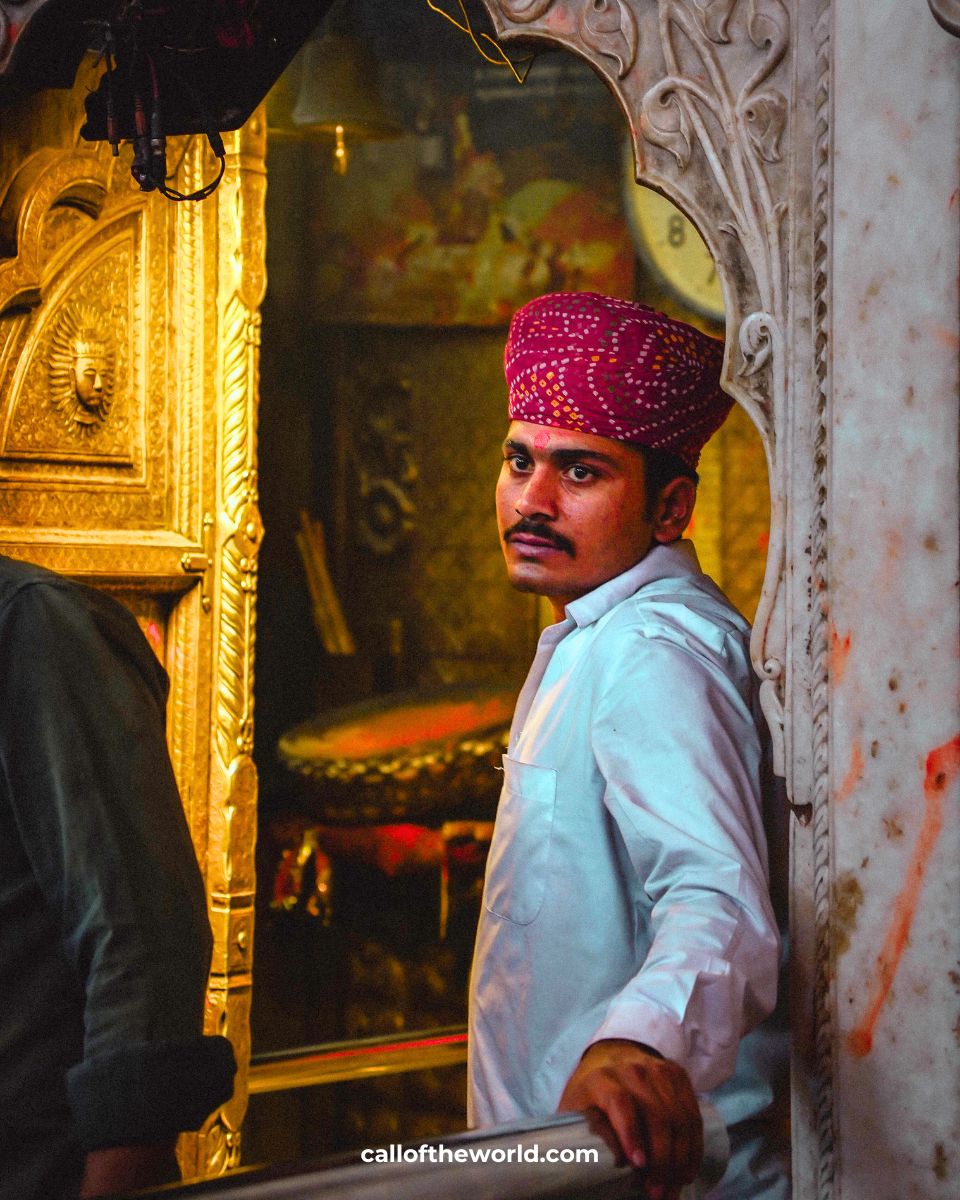
Planning 2 days in Bikaner, India? This guide has everything you need to explore one of Rajasthan’s most underrated desert cities. From majestic forts and vibrant bazaars to the best local eats, cultural curiosities, and where to stay for an off-the-beaten-path experience – and of course, the famous “rat temple”.
2 Days in Bikaner: The Ultimate Red City Itinerary
I must say, when I first heard about Bikaner it really piqued my curiosity. A “red city” perched on the edge of the Thar Desert, only around 125 kilometres from the border with Pakistan.
Bikaner has all the hallmarks of a place that should be swarming with travellers: opulent palaces, bazaars stuffed full of fabrics and spices, goats lounging in the street, and a fascinating history of Rajput dynasties and desert trade routes. And yet, unlike its more Instagram-famous cousins such as Jaipur, Jodhpur, and Udaipur, Bikaner is often quietly bypassed on the classic Rajasthan backpacker itinerary.
Why? I couldn’t quite understand it. Maybe it’s the remoteness. Maybe it’s the lack of buzz? Maybe everyone prefers just to follow the same route? But that only made me more determined to go. What I found was a city that felt refreshingly untouched by mass tourism, and all the more magical because of it. Read on for how to spend 2 days in Bikaner.


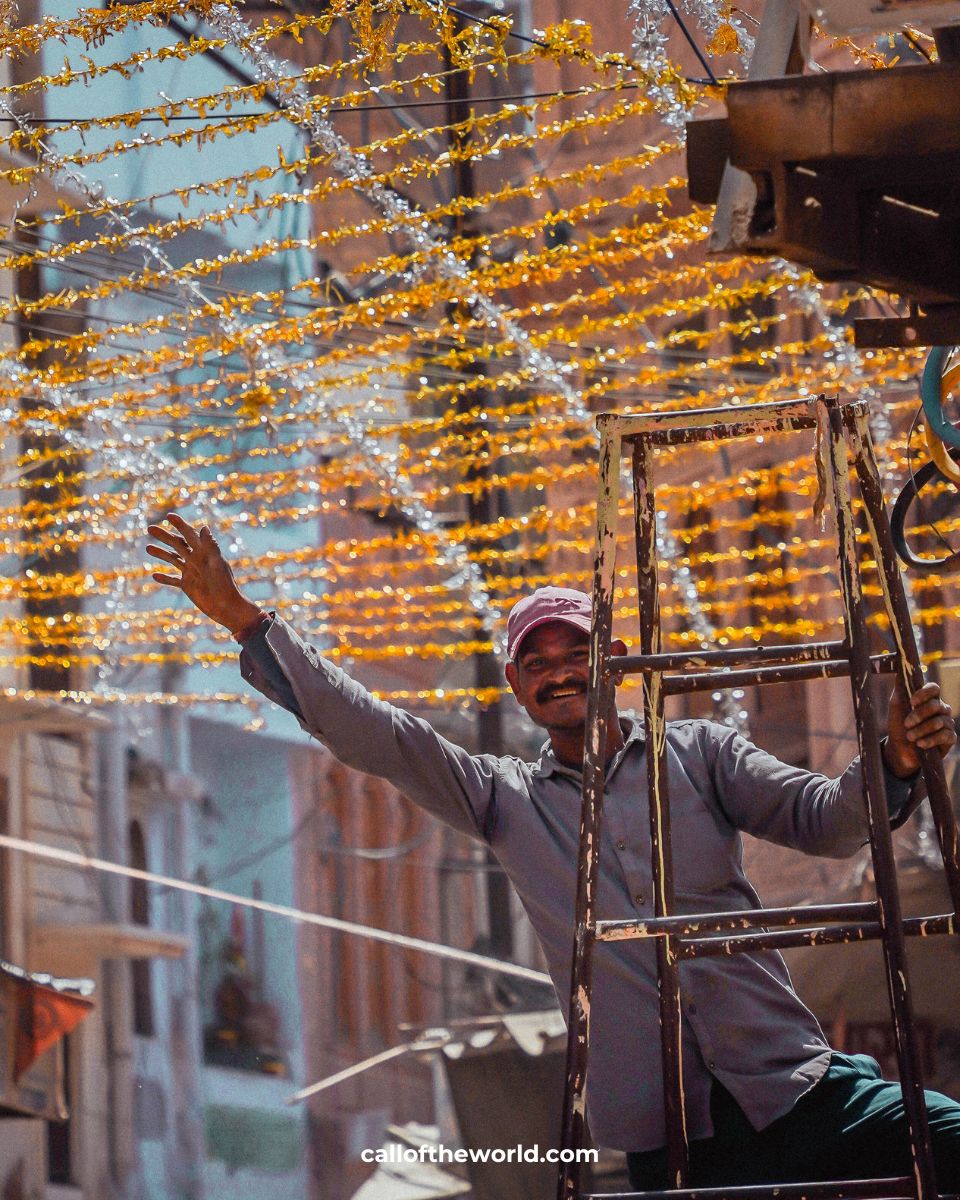
2 Days in Bikaner: What to Expect
Contents: What to See in Bikaner

Red City Itinerary: Day 1 in Bikaner
Explore the Red Havelis in Bikaner’s Old Town
A “haveli” is a traditional term used in India to describe a grand townhouse or mansion. Havelis typically have historical and architectural significance. Often built by wealthy merchants or nobility, they are known for intricate facades, courtyards and elaborate design details that reflect the cultural and artistic heritage of the region.
And Bikaner is one of the best places in India to see havelis! Here, a collection of beautifully preserved red sandstone havelis lines the narrow streets of the old town. These heritage mansions in Bikaner were built in the 18th and 19th centuries by wealthy Jain and Marwari merchants, who used their fortunes from trade along the ancient caravan routes to construct opulent homes that showcased their success.
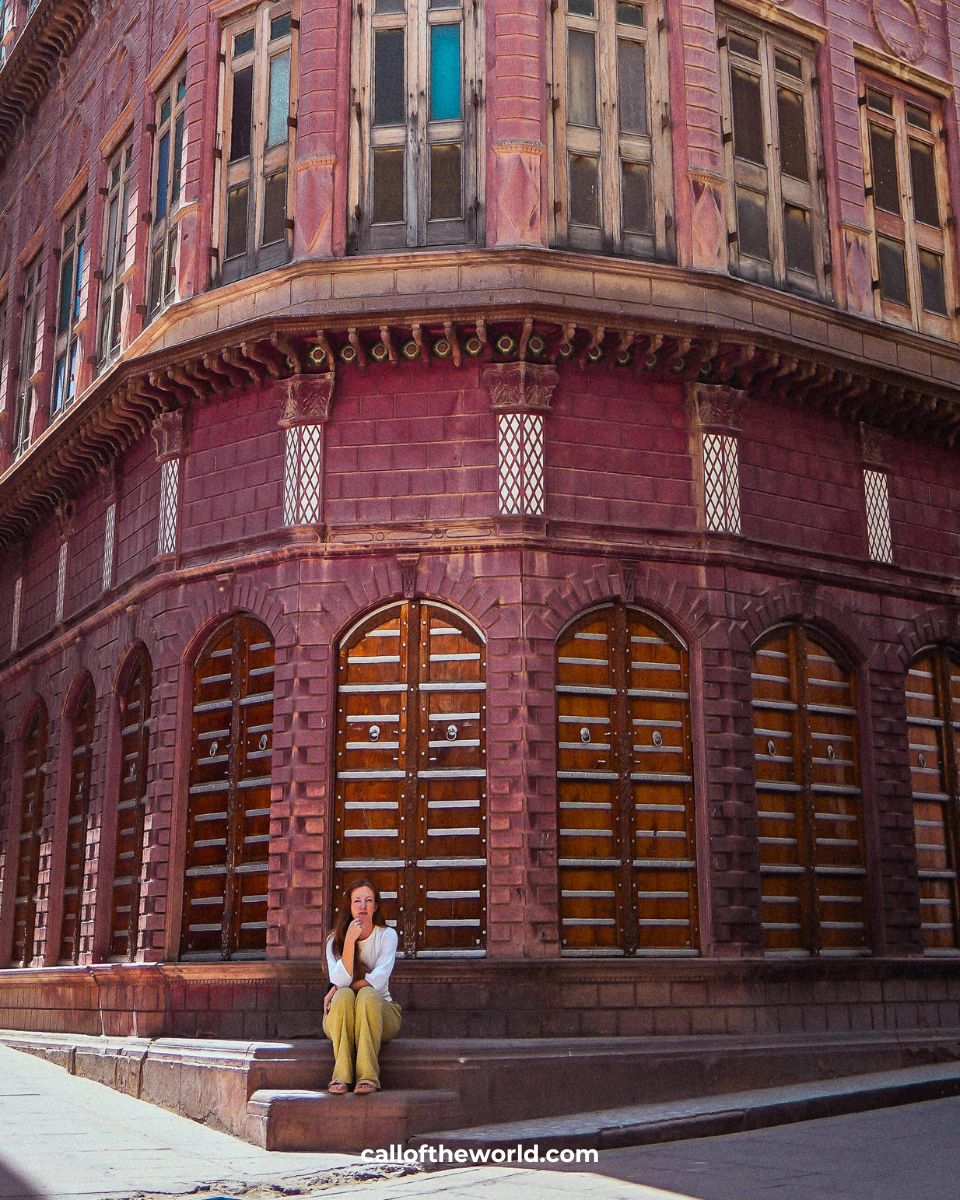
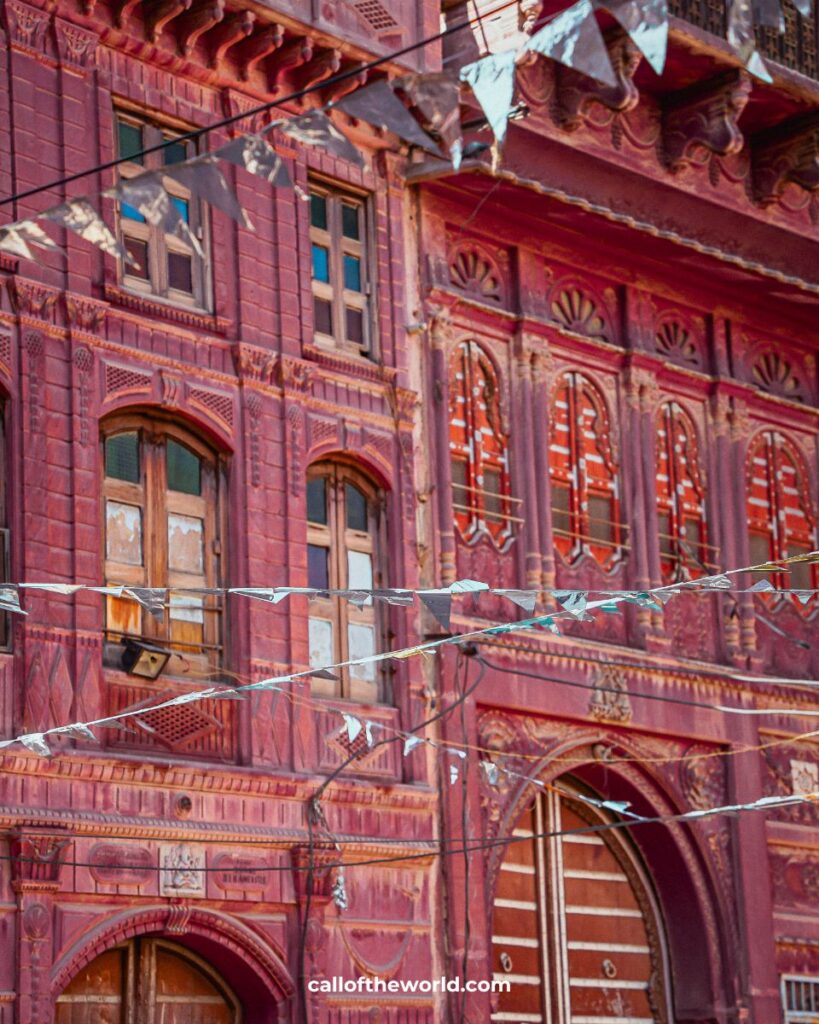
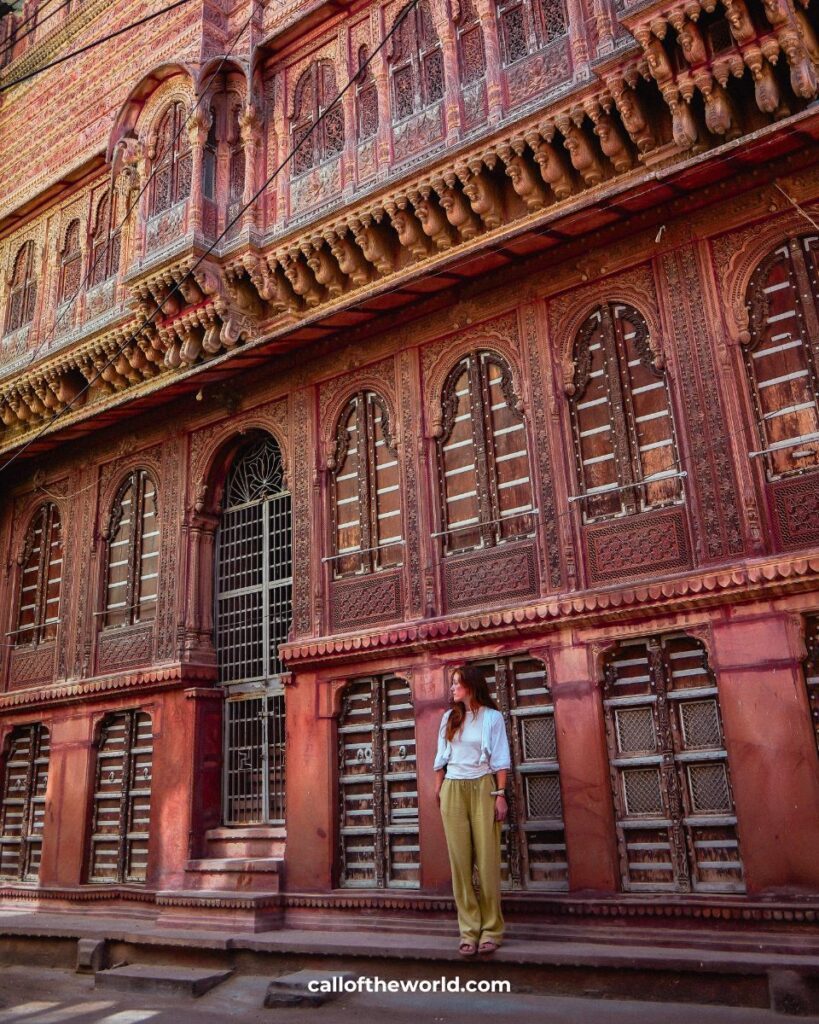
The Bikaner havelis are famed for their distinctive red sandstone architecture, carved latticework (known as jalis), and richly painted interiors. Some of the most notable havelis include Rampuria Haveli, often dubbed the “pride of Bikaner,” which stands out for its grand scale and exquisite detailing. Walking past these havelis feels like stepping back in time, with every archway and balcony telling a story of wealth and artistry.
For those interested in architecture tours in Rajasthan, or looking for offbeat things to do in Bikaner, a visit to the old havelis is a must. While many remain private residences and cannot be entered, Rampuria Haveli and a few others can sometimes be viewed from the inside via guided tours or heritage stays. Even from the outside, the experience of wandering through these historic streets of Bikaner is unforgettable. The red havelis of Bikaner offer a captivating glimpse into the region’s regal past and architectural grandeur.
Tip: I stayed at the Little Prince Guesthouse, which is nestled right in the middle of the old town, within walking distance of the havelis.
No time restriction | free-of-charge
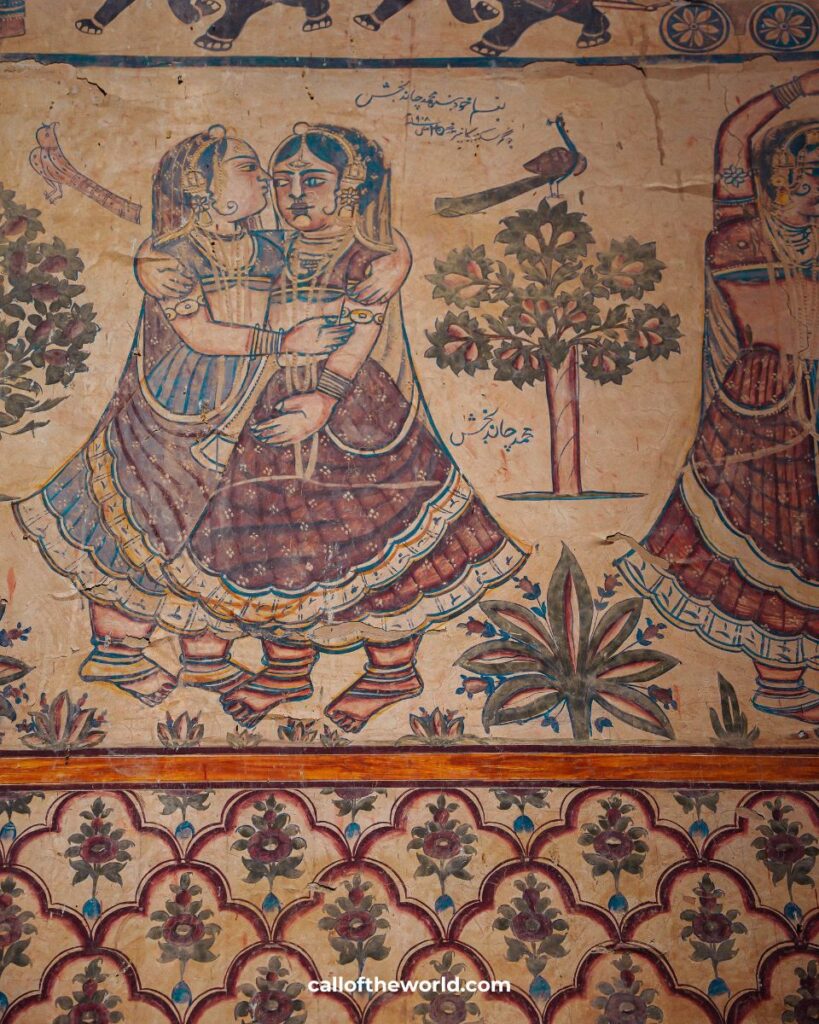
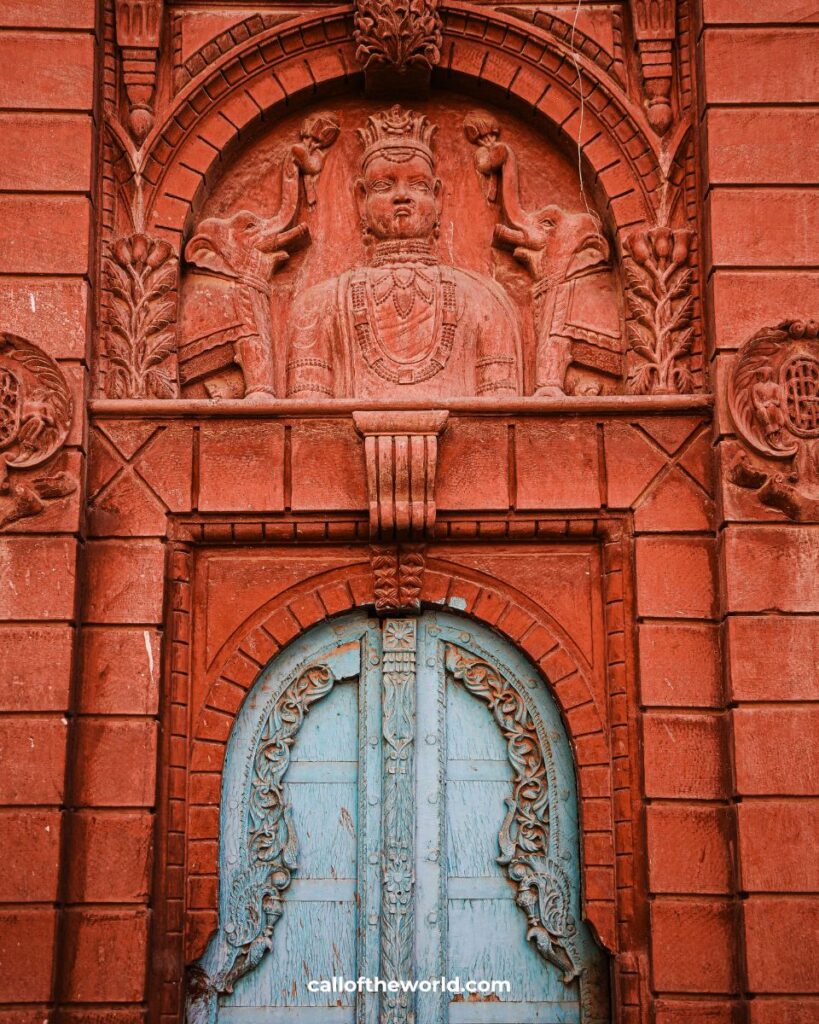
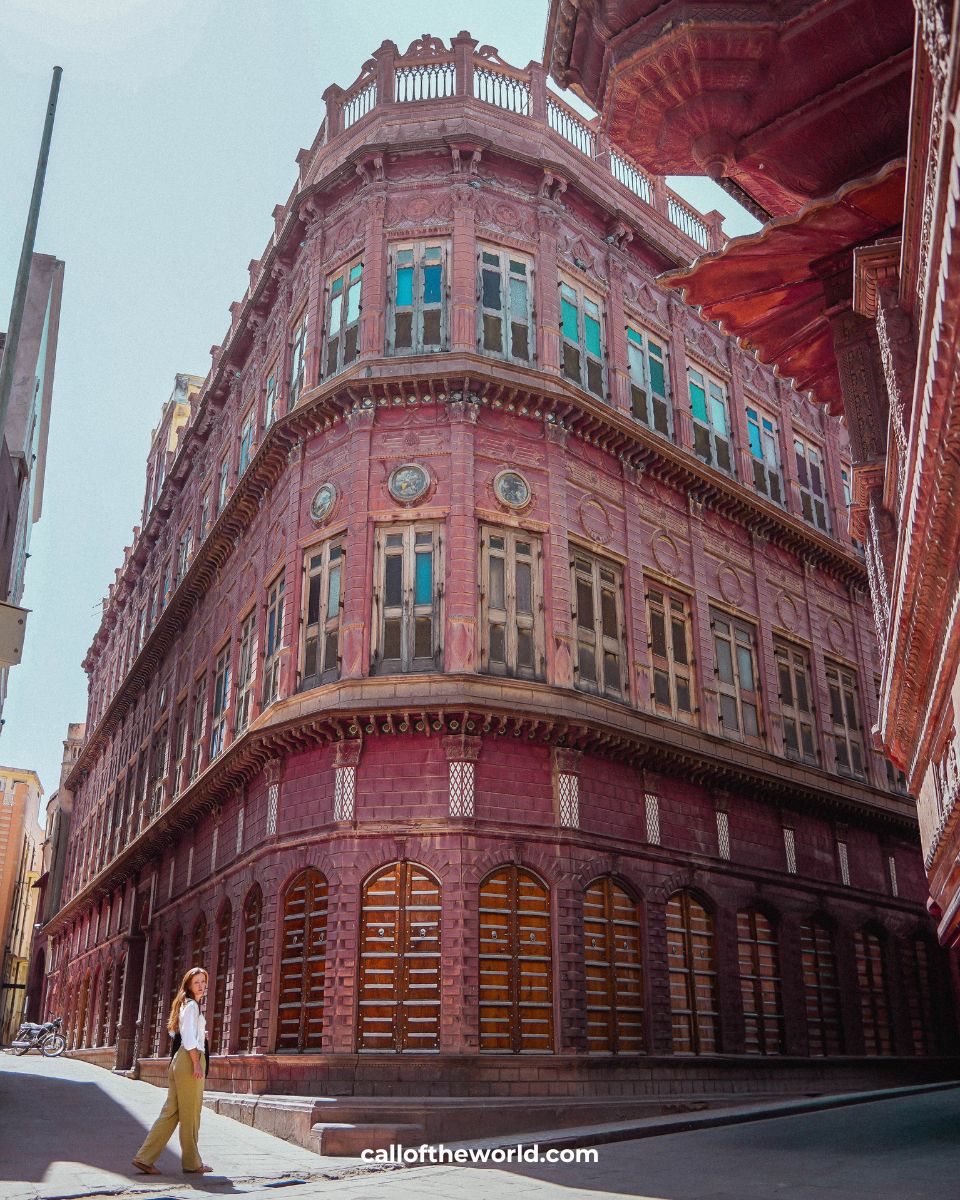
Explore Bikaner’s Old Town and Colourful Bazaar
After exploring the havelis, you can carry on walking through Bikaner’s fascinating Old Town and bustling bazaar. This historic area is a maze of narrow winding lanes and vibrant market stalls. If you’re spending a couple of days in Bikaner, set aside time to walk through this part of the city.
It’s a great place for people watching (and there are some cute cows and goats dotted around too – completely unbothered by all the scooters!).
The Old Town is packed with centuries-old buildings, many of which were once homes to wealthy merchants during Bikaner’s days as a major trade hub on the camel caravan routes. Their architecture blends Rajput and Mughal styles, with elaborately painted facades and ornate jharokhas (overhanging enclosed balconies).
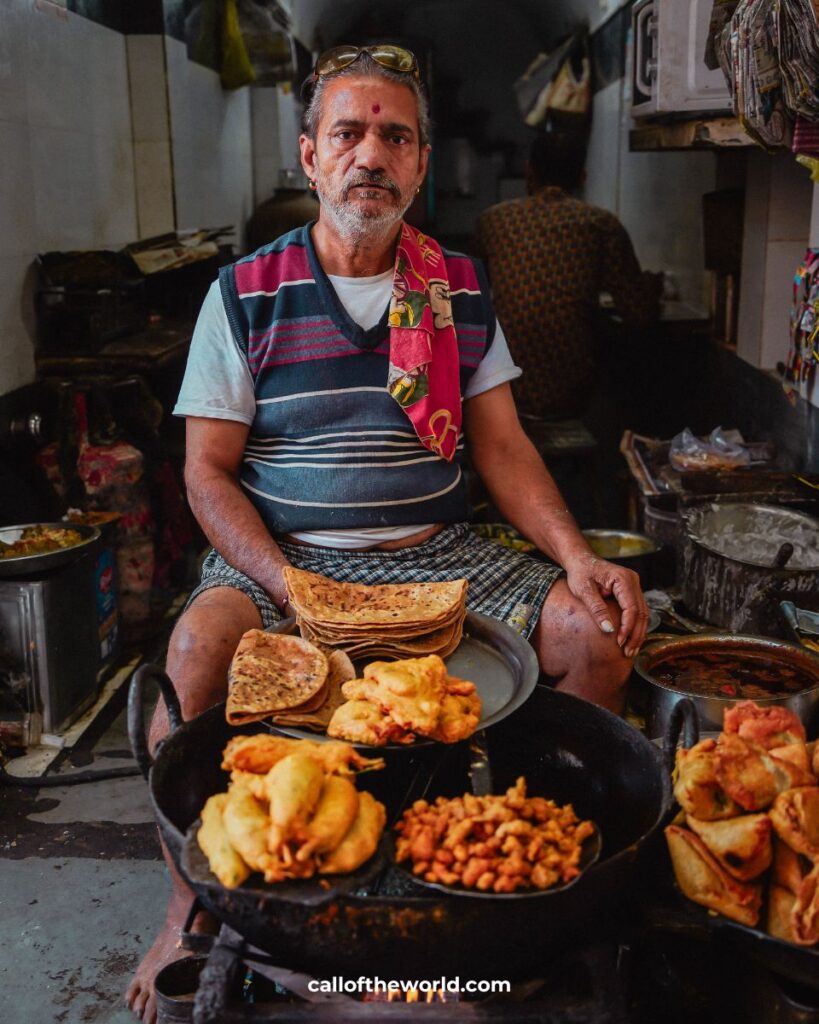
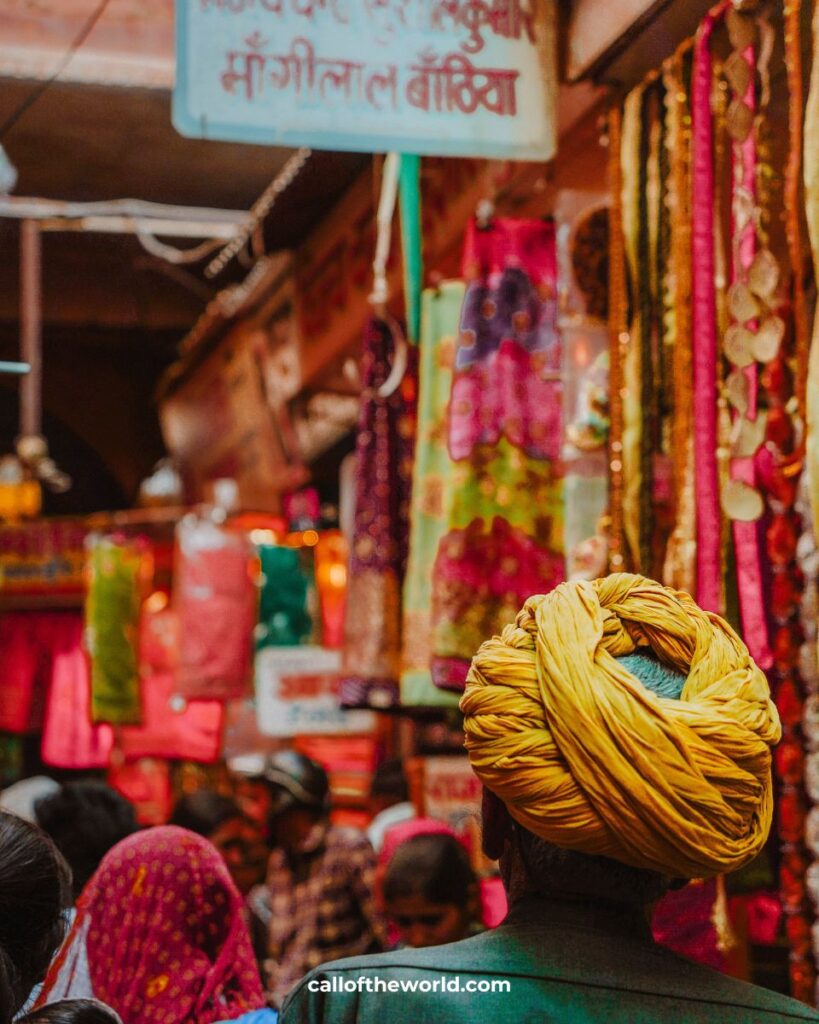
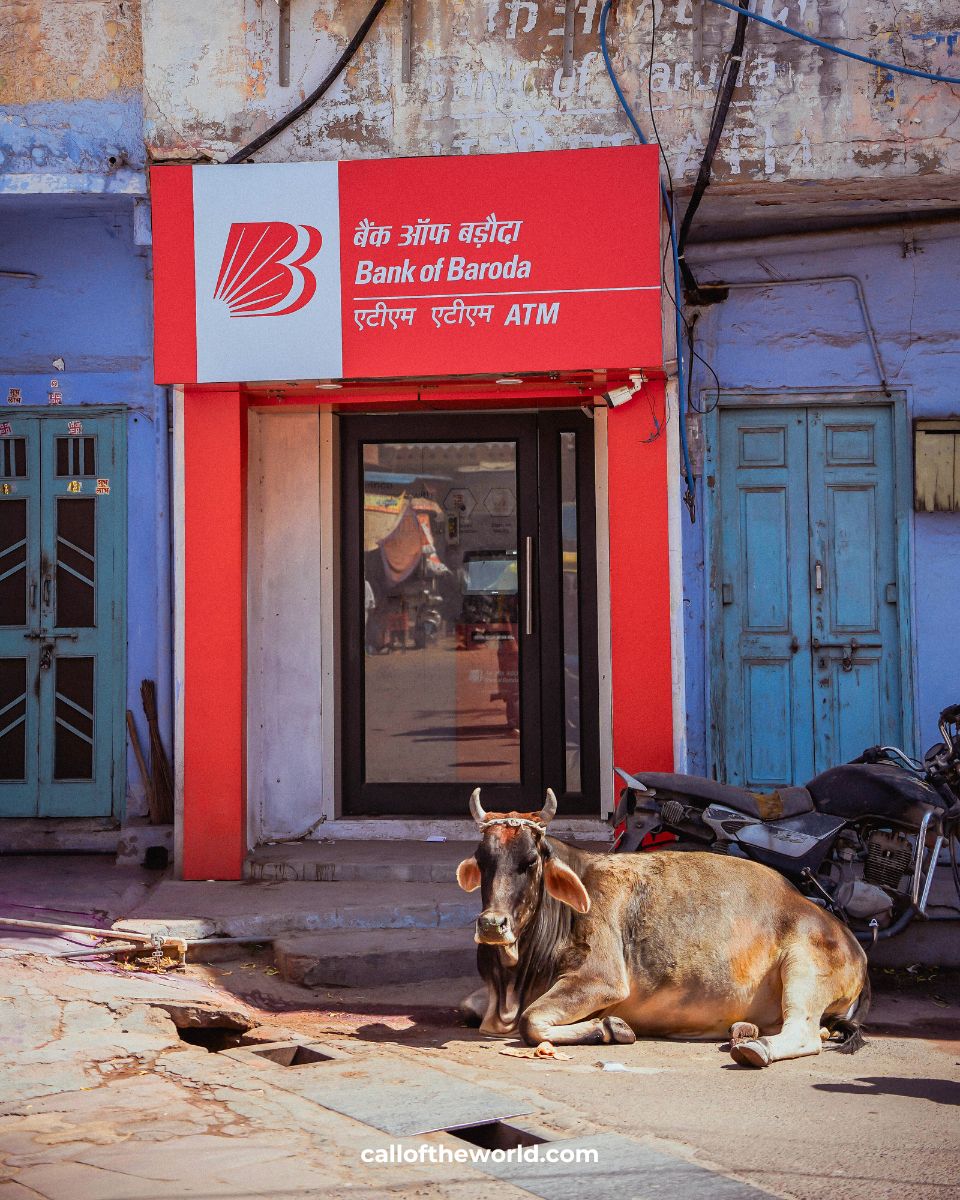
As you wander through the local bazaars of Bikaner, you’ll find stalls selling everything from traditional Rajasthani textiles and bangles to fragrant spices, sweets, and handicrafts. Don’t miss the chance to sample Bikaneri bhujia, the city’s world-famous crispy snack, or pick up some handcrafted leather mojari shoes and colourful bandhani fabrics.
Keep your camera handy as the blend of old-world charm and vibrant street life makes this part of Bikaner a dream for photographers. The Old Town is also a great place to connect with locals and experience authentic daily life in Bikaner. I have some hilarious photos where I was surrounded by a pack of school children who all wanted me to take photos of them, but I won’t publish them here as they were around that age (11-12?) where flipping the bird is the most hilarious thing ever!
Whether you’re a lover of history, architecture, street photography or shopping, exploring the Old Town and bazaar is a must-do activity when planning your 2-day Bikaner itinerary.
10am – late | free-of-charge
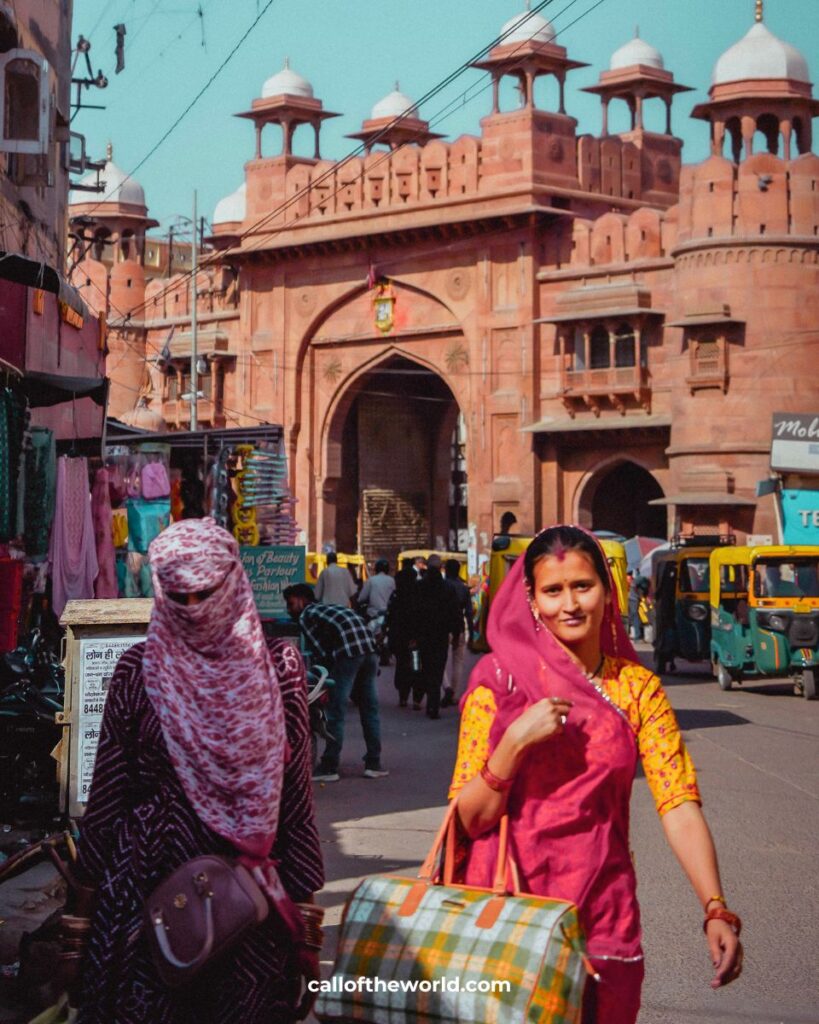
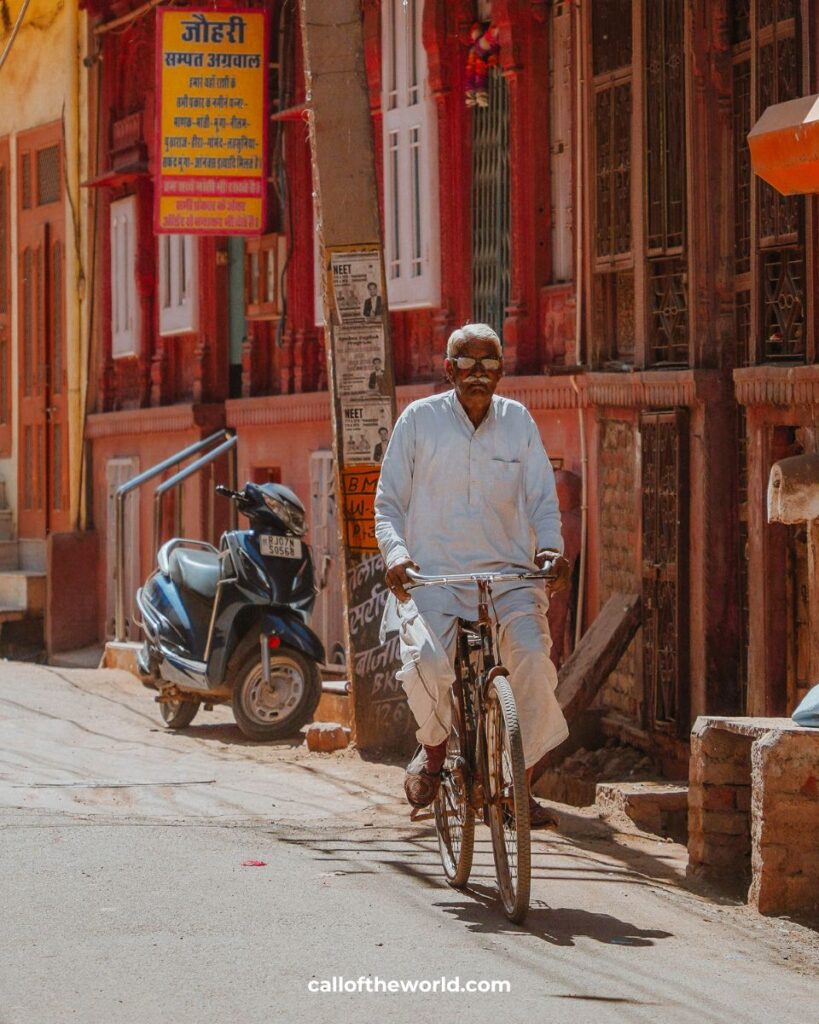
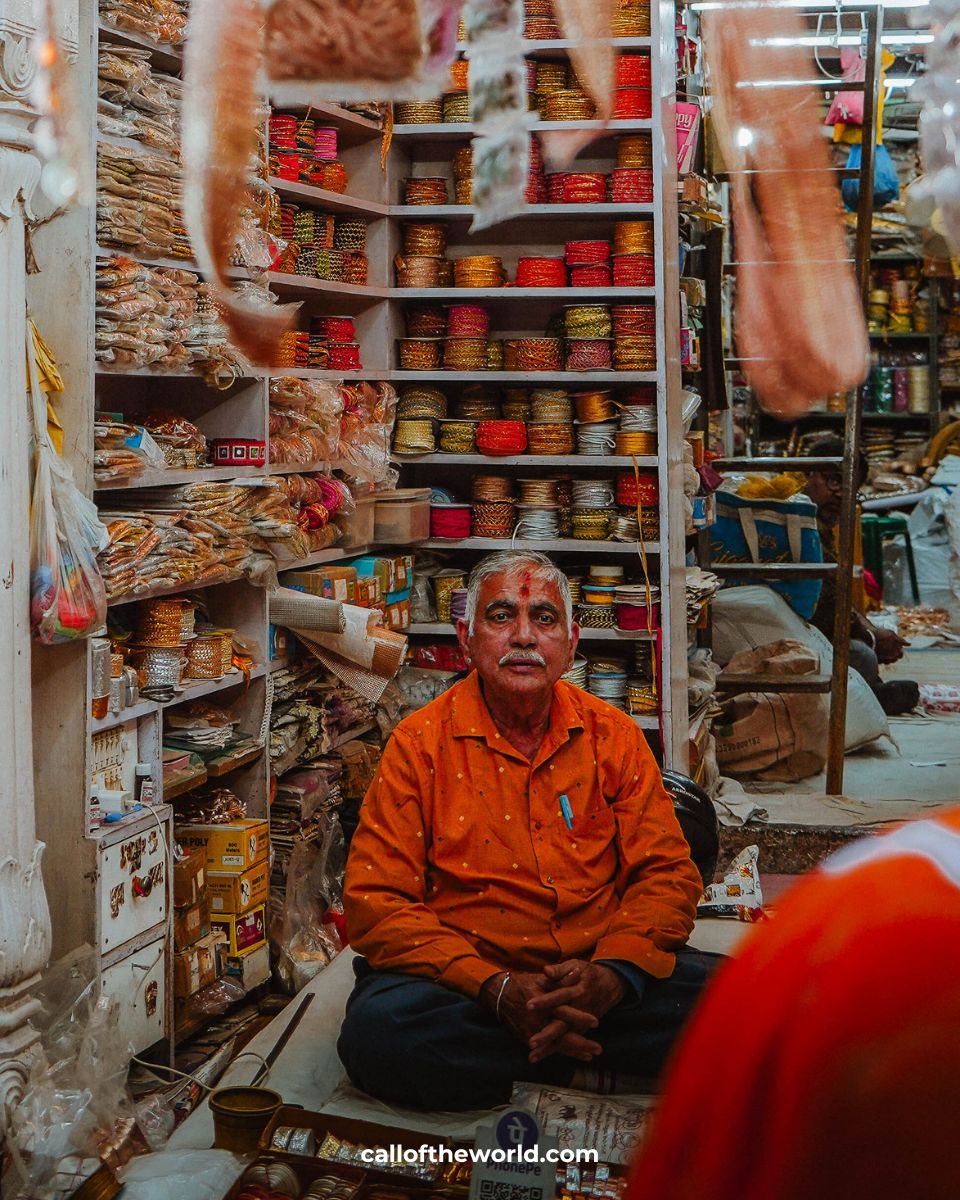
Cool Down with Chunnilal Sharbat – A Bikaner Tradition
Did I mention that it gets hot in Bikaner? And that combined with the dry desert air will make you pretty parched! But fret not – the locals have a solution for that: sharbat. And it’s delicious.
One of the best places to try this cool sweet treat is Chunnilal Tanwar Sharbat Wale, a beloved local institution in Bikaner’s old city. This tiny stall has been serving up handmade, cooling sharbats for generations, using natural ingredients that are perfect for rehydrating in the desert heat.
Expect exotic flavours like rose, clove, and saffron. Stopping for a sharbat is more than just a way to cool down – it’s a chance to experience a slice of authentic Bikaneri culture, mingle with locals and enjoy a refreshing pause in your sightseeing itinerary.
Oh and the cute pottery cups are disposable. They go in the bin. Everyone had a good-natured giggle when I tried to hand mine back!
10am – late | see menu for prices
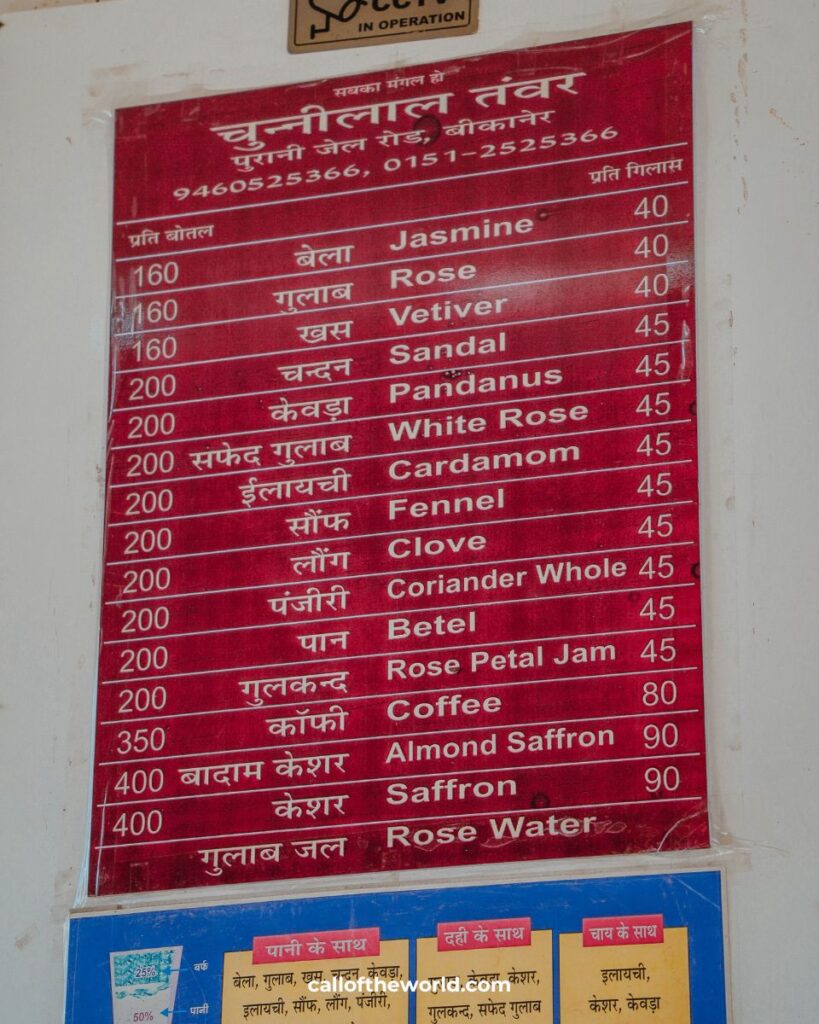
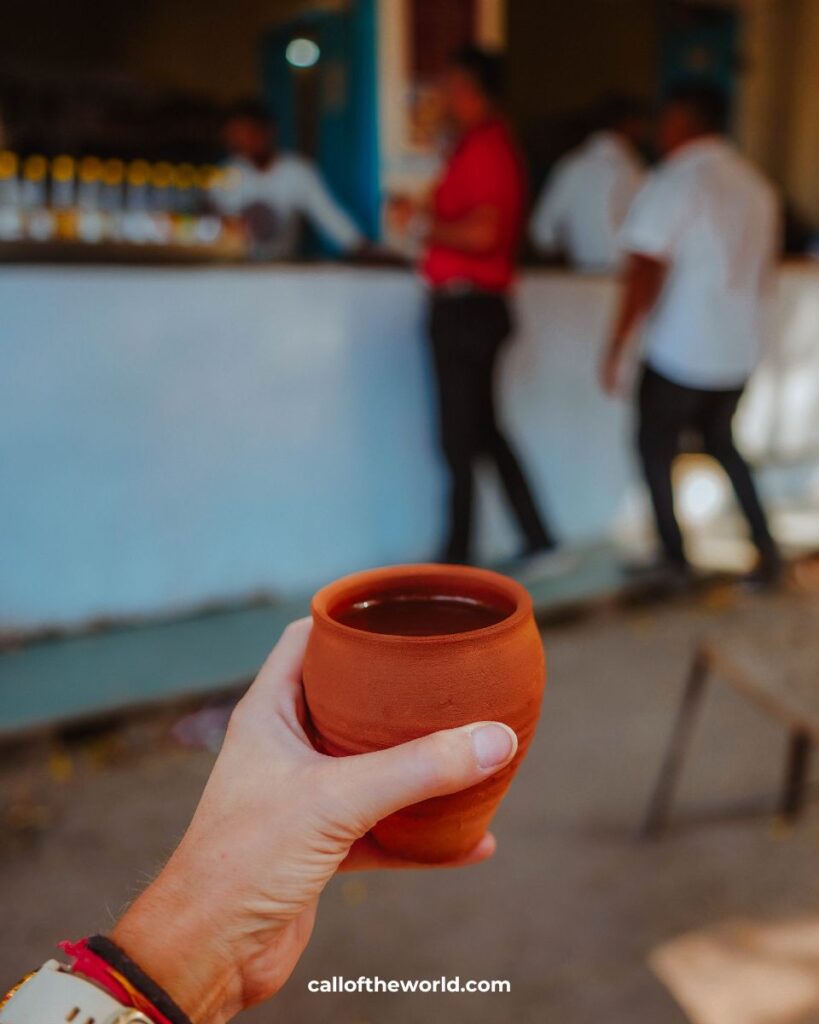

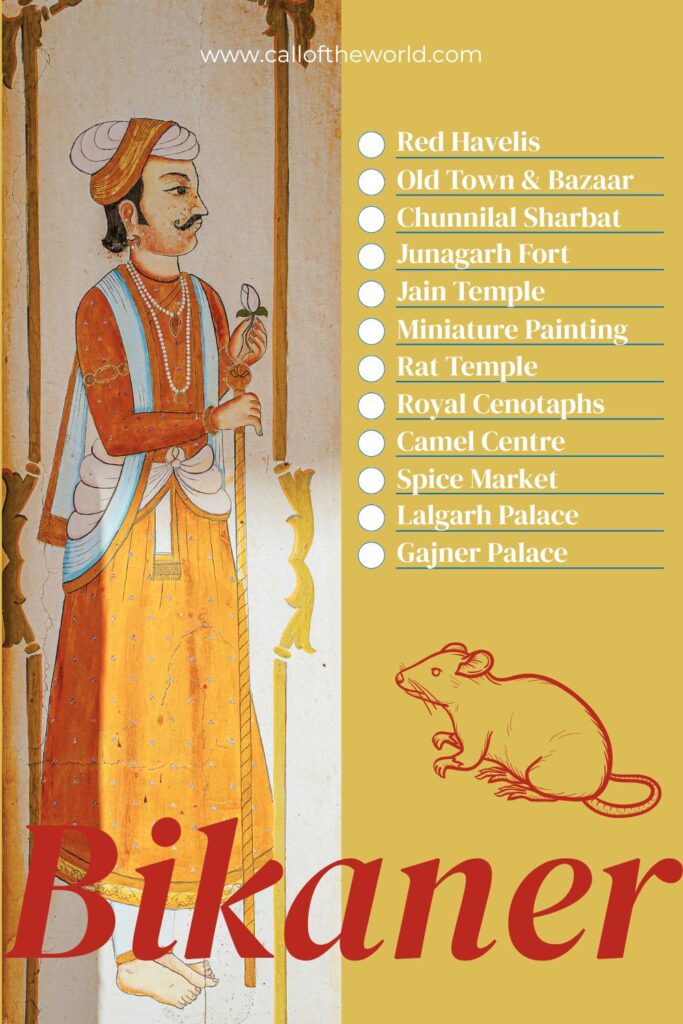

Discover the Grandeur of Junagarh Fort
Junagarh Fort is one of Rajasthan’s best-preserved and most visually striking forts. Unlike many forts in India, Junagarh was not built on a hilltop, making its massive stone ramparts and bastions all the more imposing as they rise dramatically from the desert plains.
Built in the late 16th century by Raja Rai Singh, a trusted general in Emperor Akbar’s army, the fort is a stunning blend of Rajput, Mughal, and Gujarati architectural styles. The complex houses a series of exquisite palaces, temples, pavilions and courtyards, each more intricately carved and decorated than the last.
Visitors can marvel at the Phool Mahal (Flower Palace), Anup Mahal, and the Chandra Mahal, all adorned with mirror work, gold leaf, and hand-painted murals. The fort museum showcases royal weaponry, costumes, manuscripts and ancient artefacts.
10am – 4:30pm | ₹50 for Indian citizens, ₹300 for foreign tourists
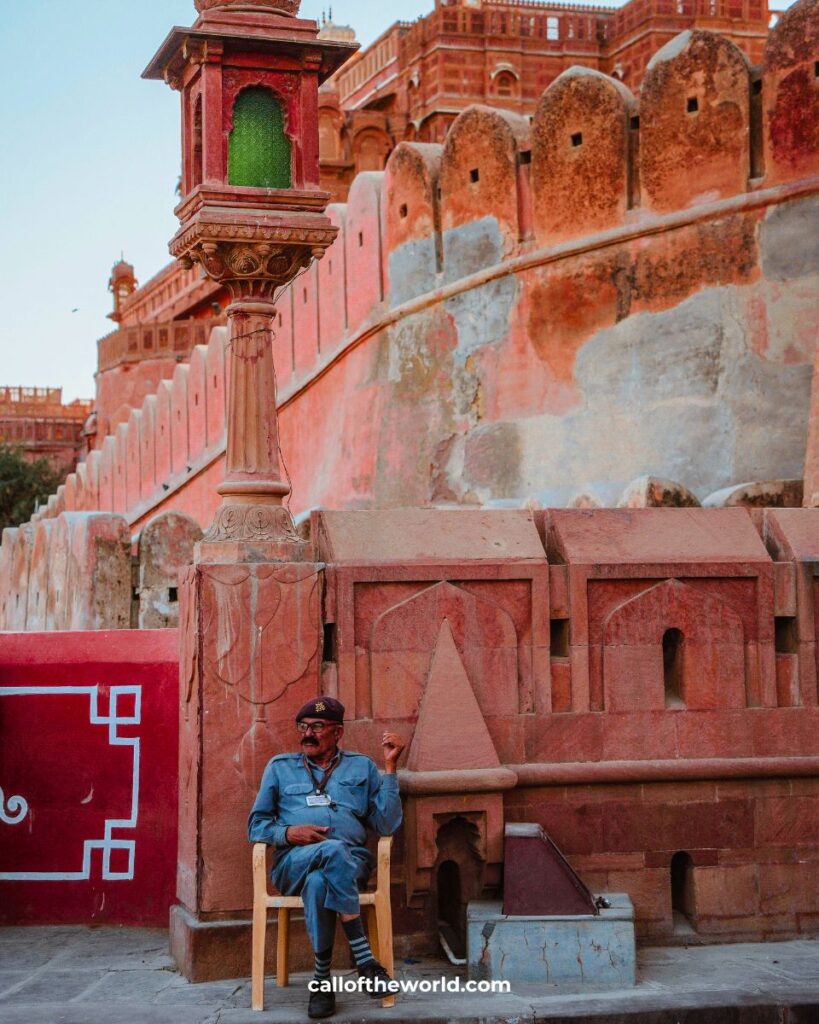
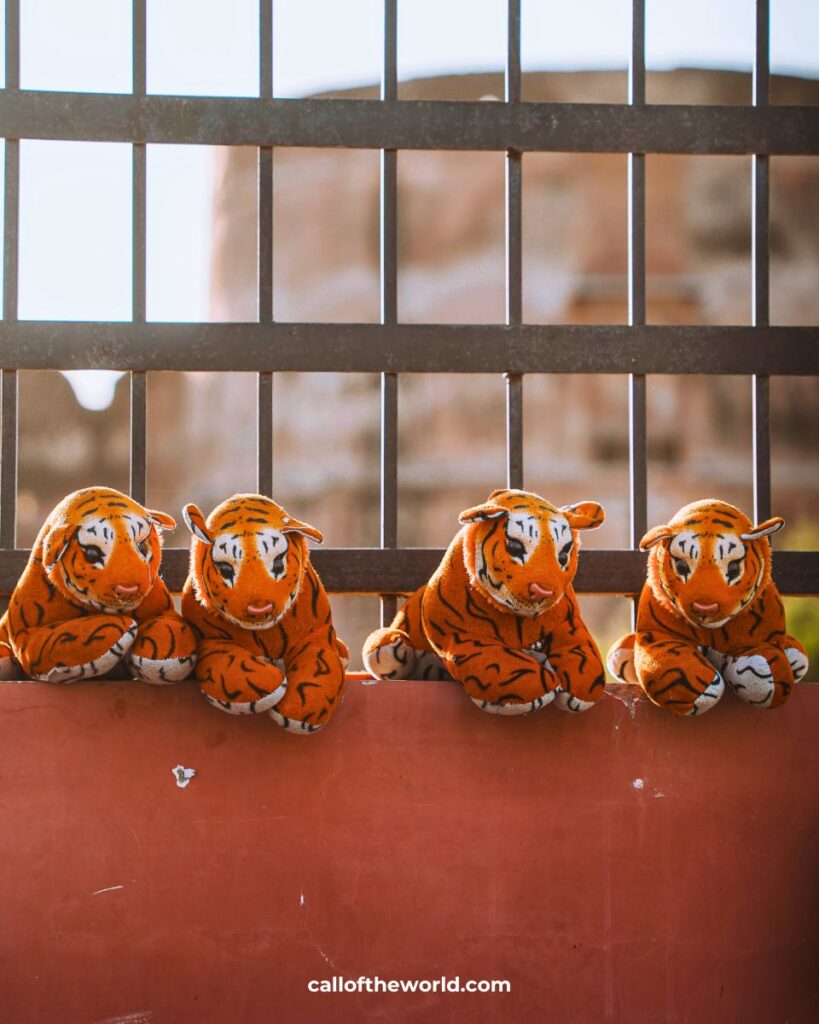
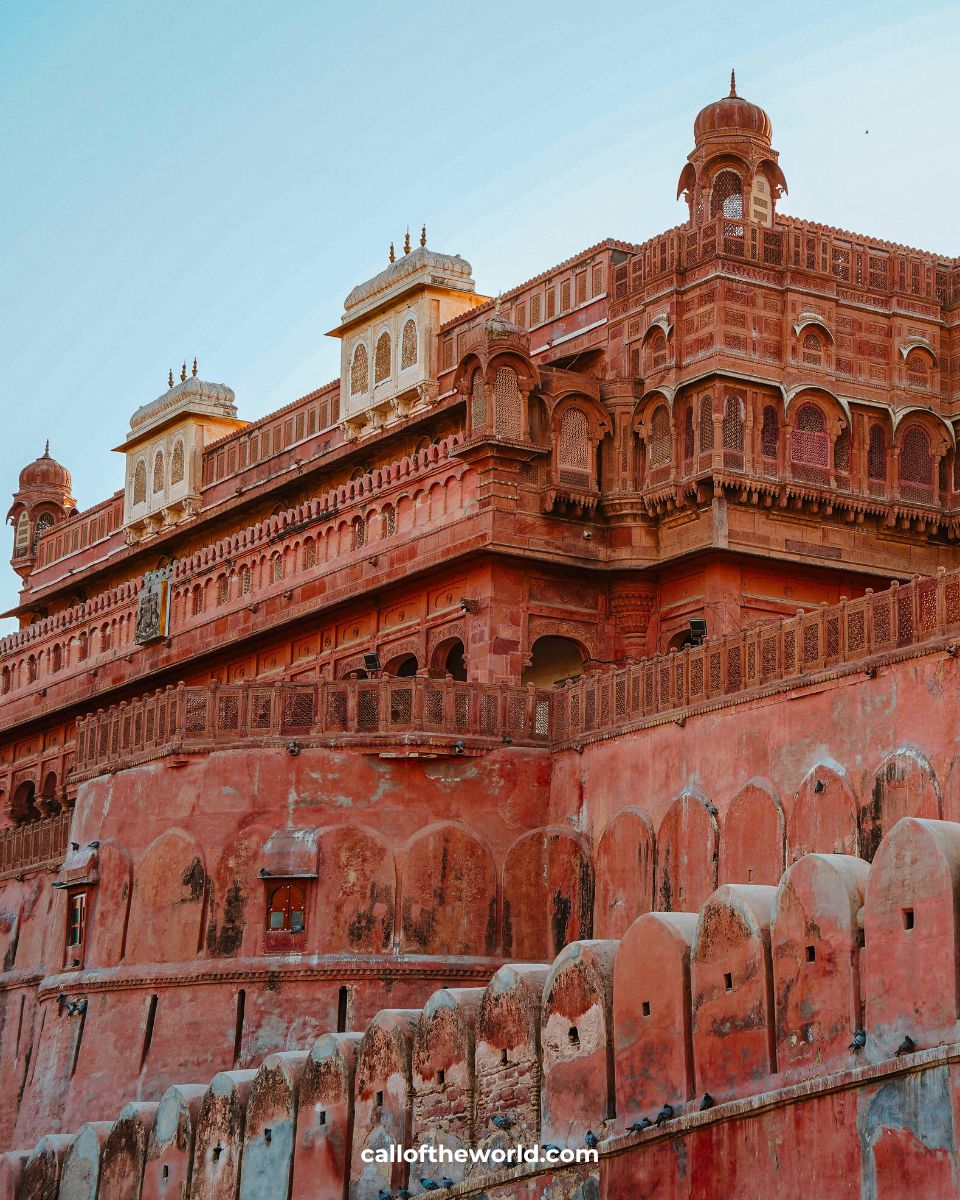
Visit Seth Bhandasar Jain Temple, Bikaner’s Hidden Gem
Now for one of my favourite places in Bikaner, the magical Seth Bhandasar Jain Temple. Hidden away behind some metal gates at the edge of the old town, it would be easy to miss it if you didn’t know it was there.
This 15th-century temple is one of the most beautiful and intricately decorated Jain temples in Rajasthan. Built by a wealthy Jain merchant named Bhandasa Oswal, the temple is dedicated to the fifth Tirthankara, Sumatinatha.
What makes this temple especially fascinating is not just its exquisite carvings and frescoes, but also the legend that the construction used 40,000 kilograms of ghee (clarified butter!) instead of water in the mortar. Whether that’s true or not, the building is undeniably breathtaking.
The walls and ceilings are covered in vibrant paintings and detailed mirror work, with themes drawn from Jain mythology and everyday life in ancient times.
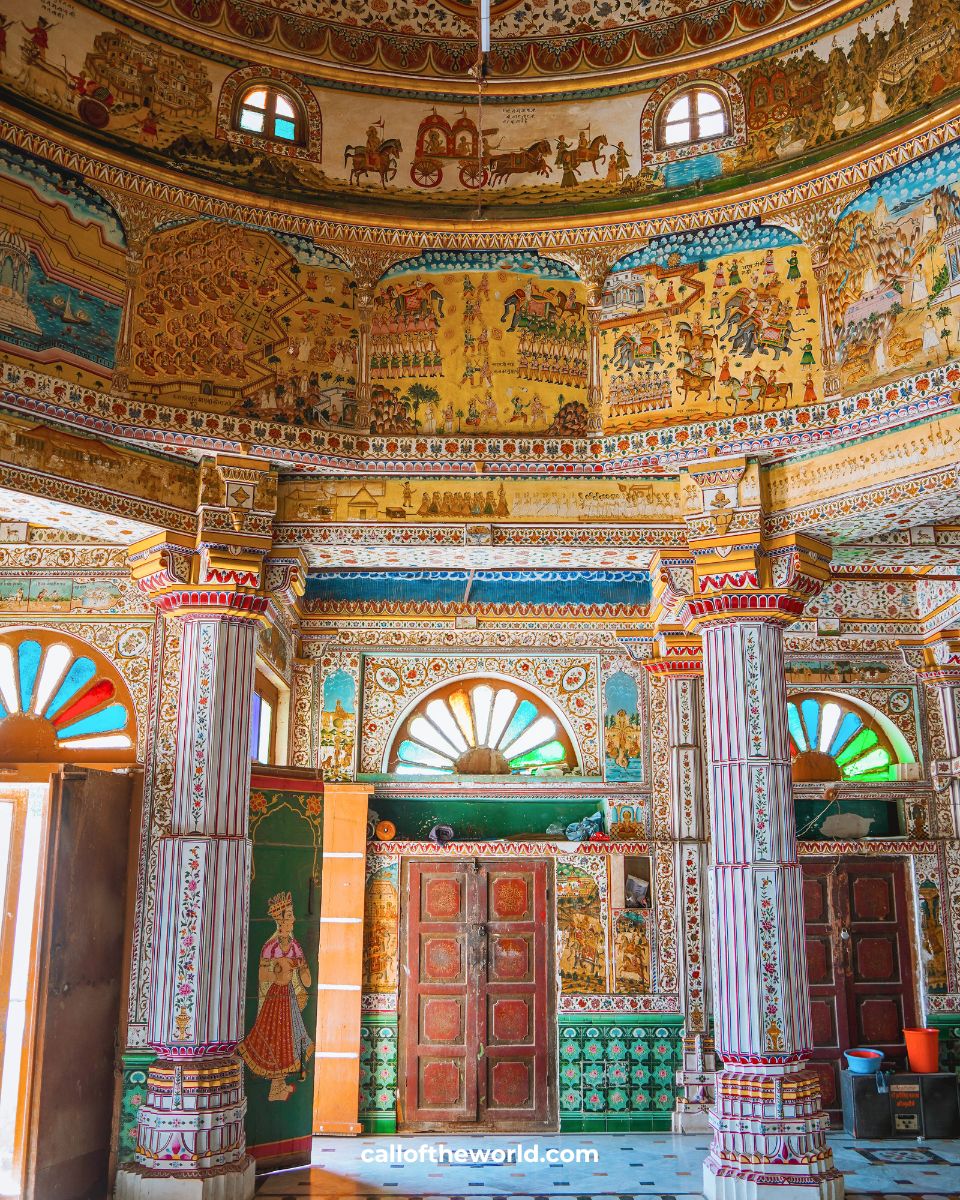
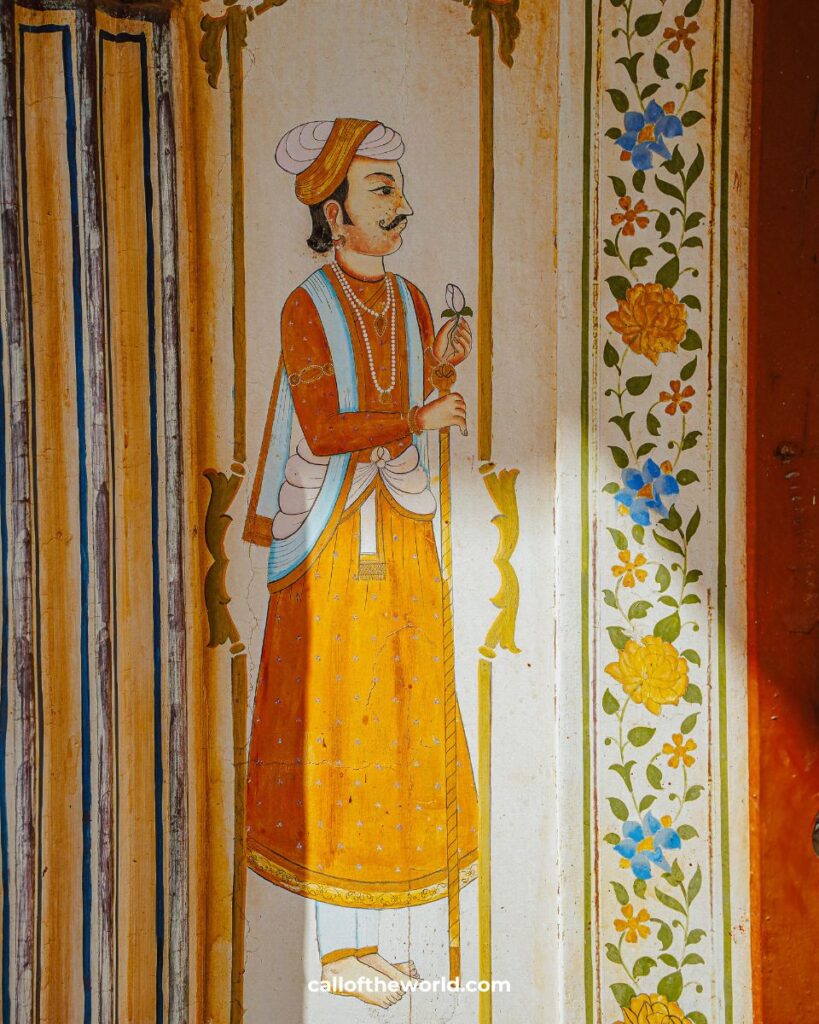
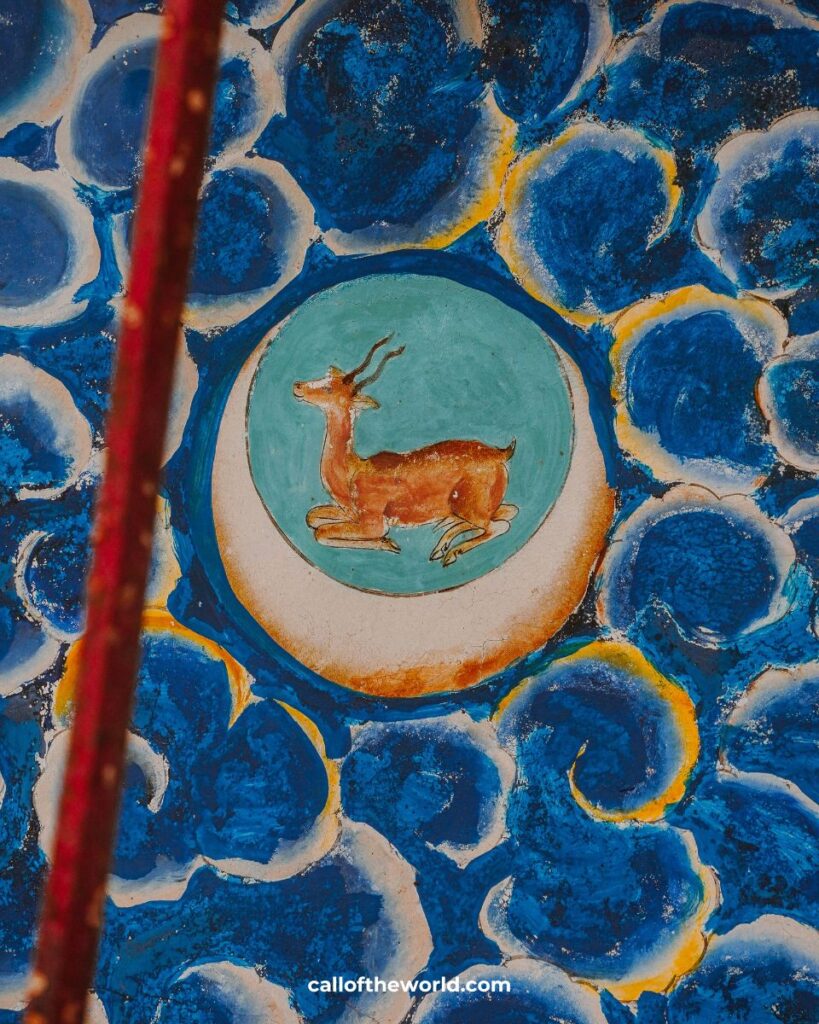
Bhandasar Jain Temple is less crowded than many other attractions in Bikaner (I had it to myself!) which means you can really take your time to admire the craftsmanship and soak up the peaceful atmosphere.
It’s also a great place for photography, thanks to the rich colours, intricate patterns, and natural light that filters through the arched windows.
A note on the outside gates – it’s a small door within the gate that you need to open and step through, not the whole entire gate. The first time I visited some lady tried to tell me it was closed and then lure me to her house – I didn’t go so I don’t know why, but I suspect some sort of scam.
5am – 9pm | free-of-charge | donations encouraged
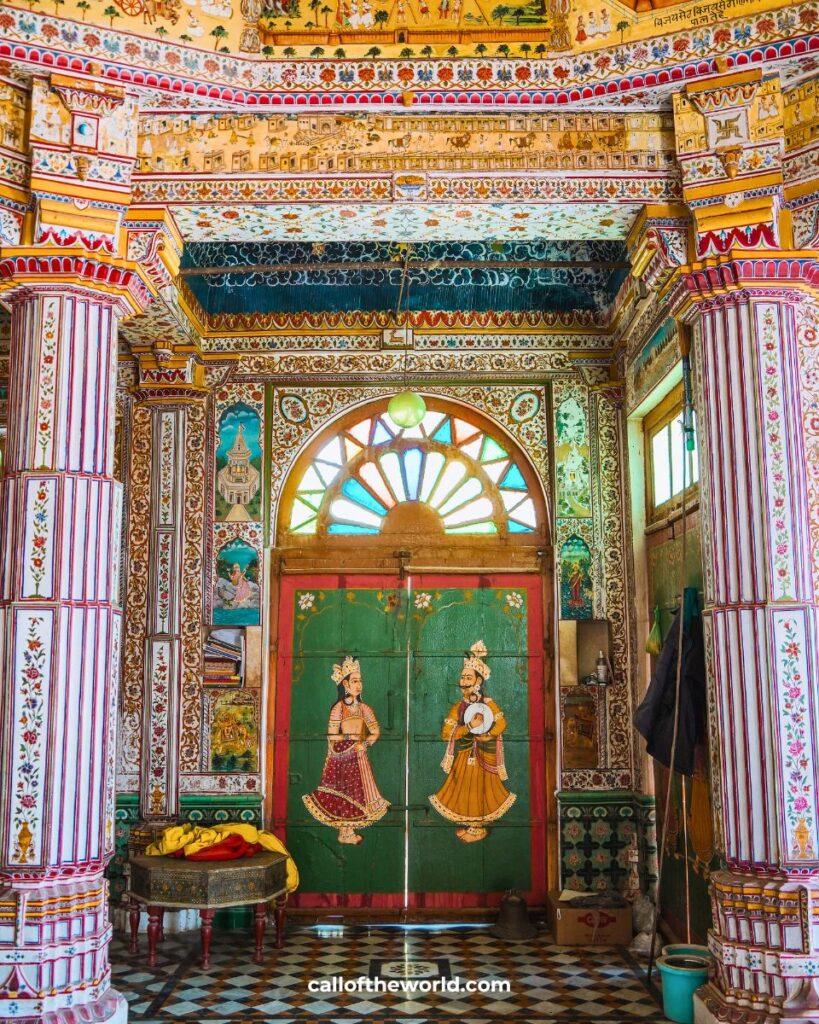
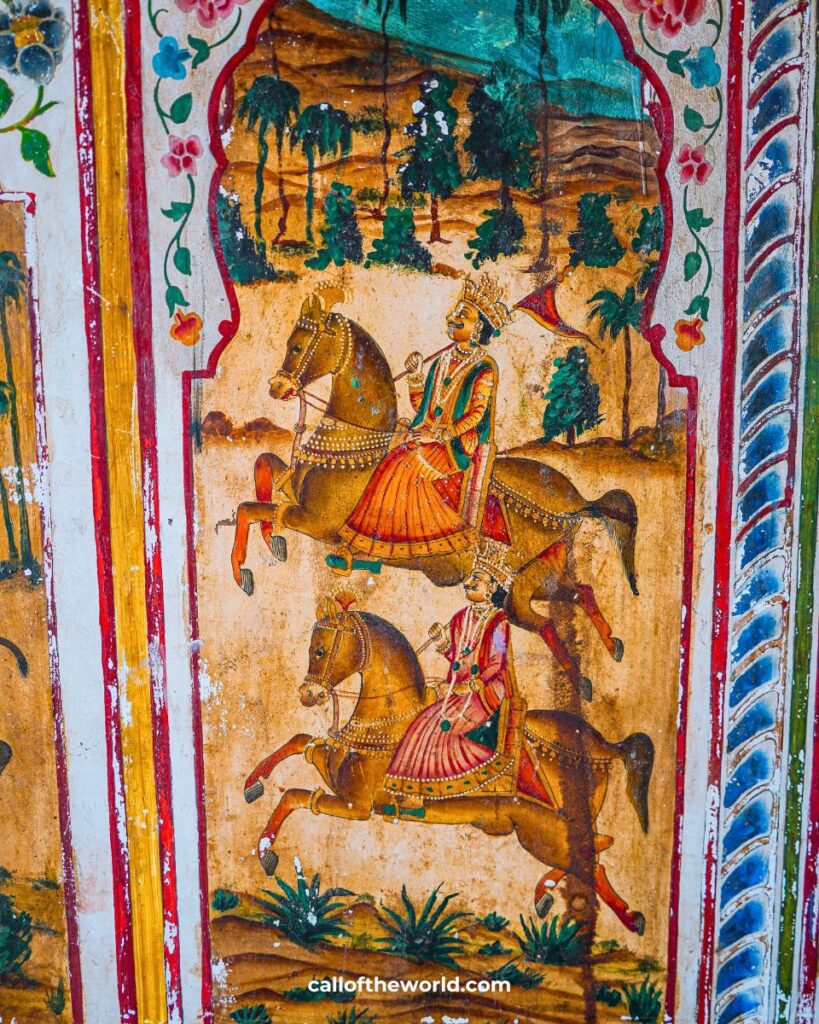

Discover the Art of Miniature Painting in Bikaner
One of the most captivating traditional arts you can experience during your 2 days in Bikaner is miniature painting. This is a centuries-old craft that is very typical of Rajasthan, which came from the merging of Indian and Mughal painting styles.
During my visit to Bikaner, I had the privilege of meeting an artisan who has dedicated years to perfecting this intricate and delicate form of painting.
Each piece is a labour of love, often taking weeks or even months to complete. These paintings are created using ultra-fine brushes and natural pigments, and they typically portray historic events, scenes from Rajasthani folklore or detailed depictions of nature and animals, all rendered with incredible precision and patience.
If you’re looking for authentic things to do in Bikaner, don’t miss the chance to visit a local studio or gallery where you can meet these artisans in person, learn about their techniques, and even purchase a one-of-a-kind piece to take home. This is more than just a souvenir, it’s a piece of Rajasthani art history.
Opening times vary | Free-of-charge to visit | Artworks priced individually
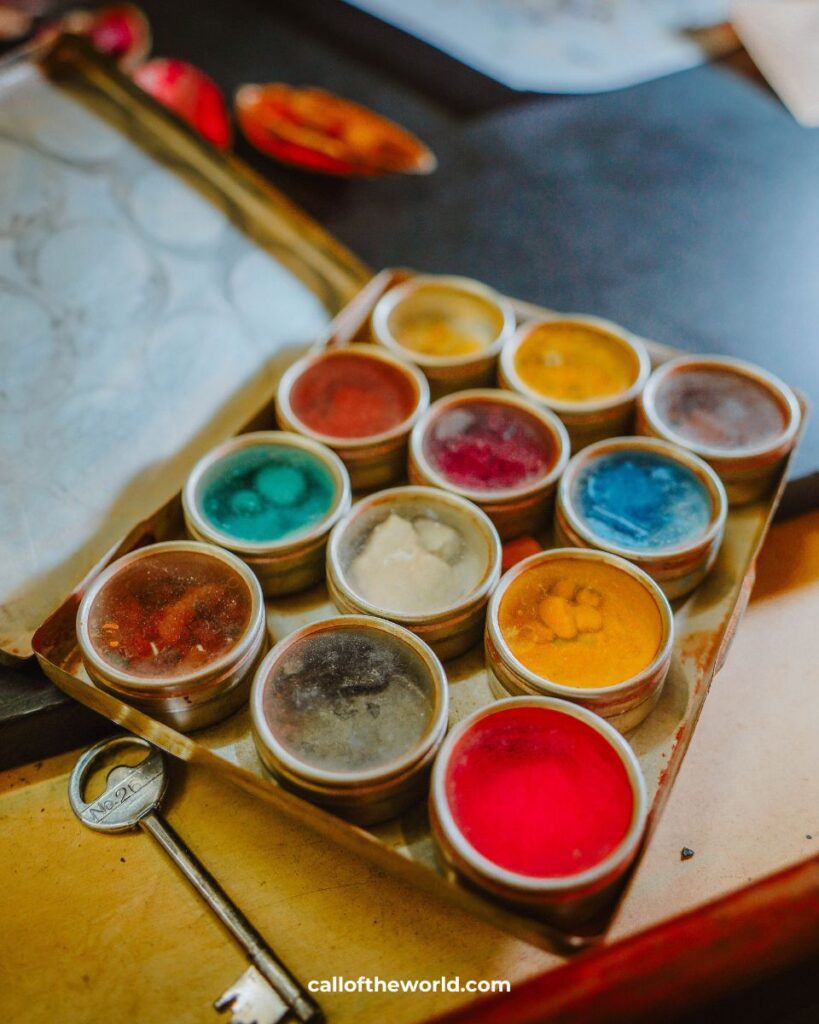
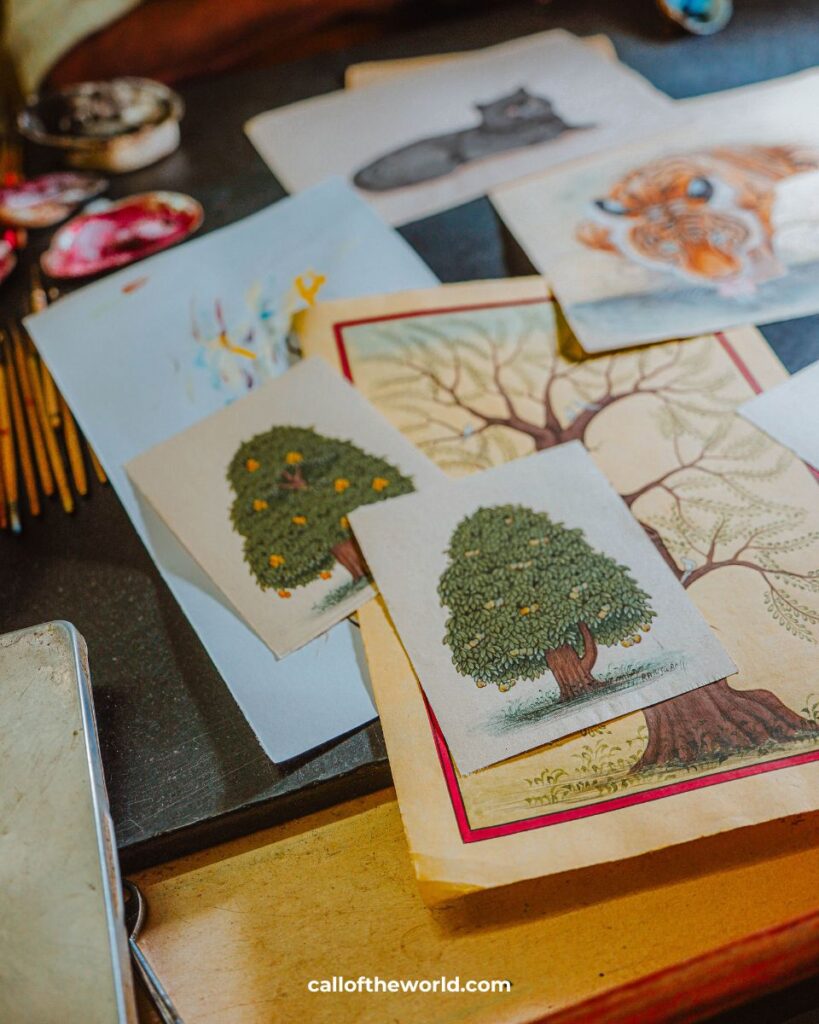
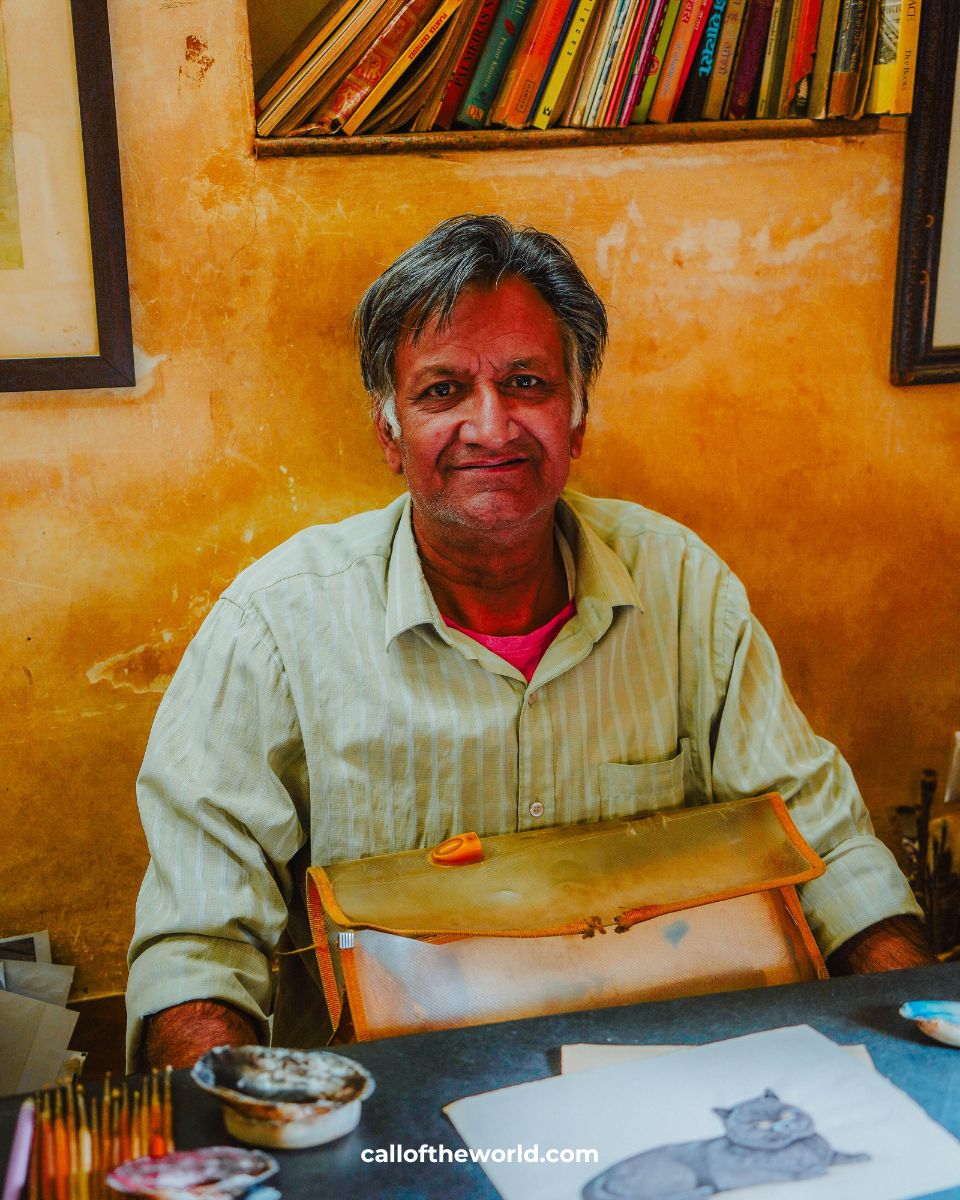
Red City Itinerary: Day 2 in Bikaner
Visit the Famous Rat Temple: Karni Mata Temple in Deshnok
No itinerary for 2 days in Bikaner is complete without a visit to the Karni Mata Temple, famously known as the Rat Temple near Bikaner. Located in the small town of Deshnok, about 30 kilometres south of Bikaner itself, this temple is one of the most unique religious sites in India and draws thousands of curious travellers and devotees each year.
Read my more detailed post: Visit India’s Famous Rat Temple: Karni Mata in Deshnoke, Rajasthan
The Karni Mata Temple is dedicated to Karni Mata, a revered 14th-century mystic believed to be an incarnation of the Hindu goddess Durga. What makes this temple world-famous is its resident population of over 25,000 sacred rats, known as kabbas. These rats are considered holy and are protected, fed and worshipped by devotees.
Be warned – you’ll need to walk barefoot (shoes must be removed) through the marble corridors of the temple, where you’ll see the rats scurrying across the floor to feed from large metal bowls of milk and grain. I’m not too fazed by this kind of thing, but for a lot of people it might not be your cup of tea! Oh and by the way, spotting a white rat, considered especially auspicious, is said to bring good luck and blessings.
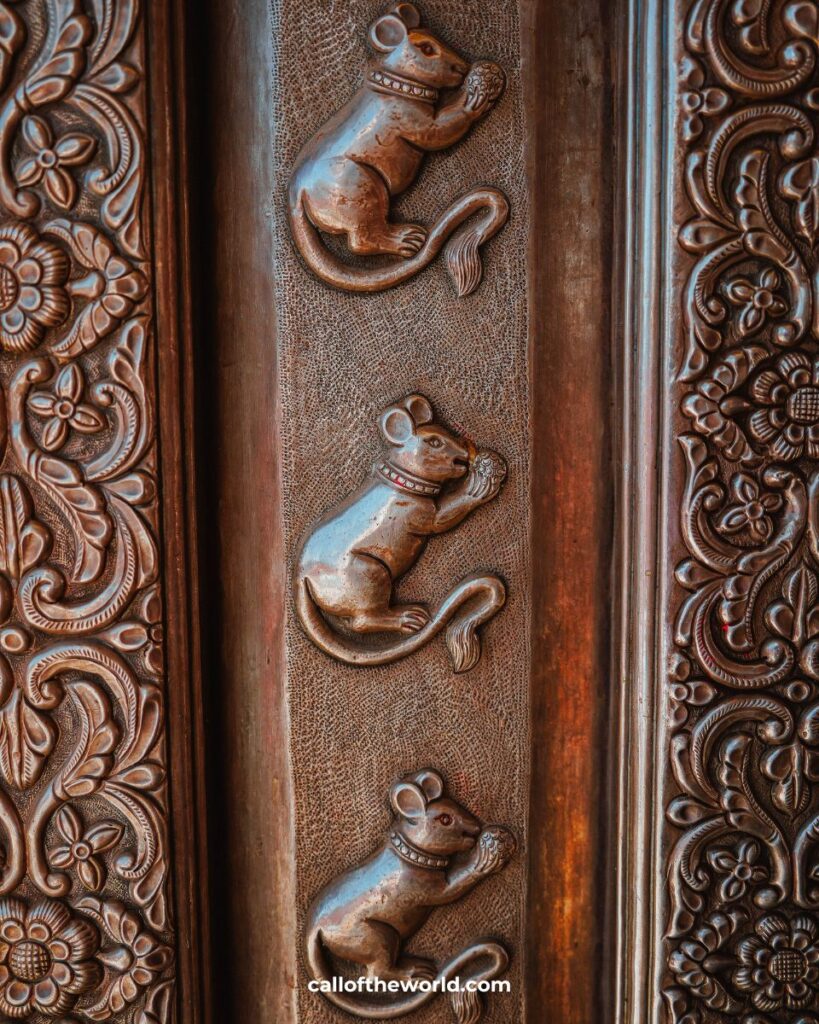
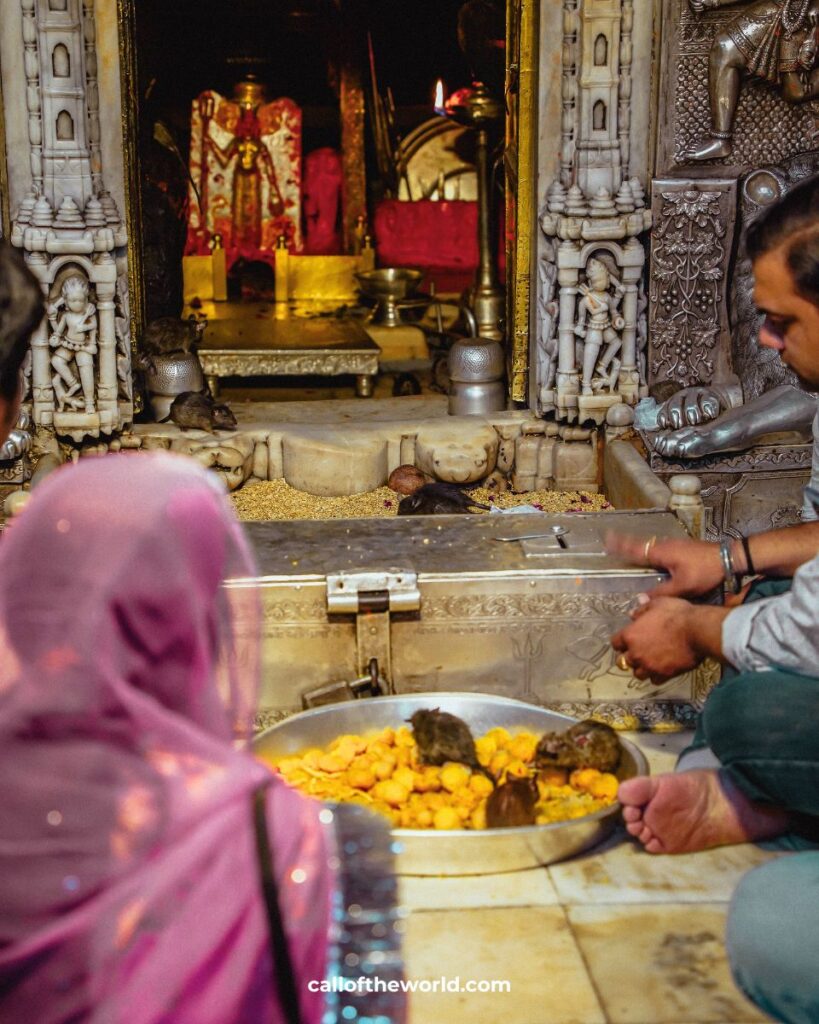
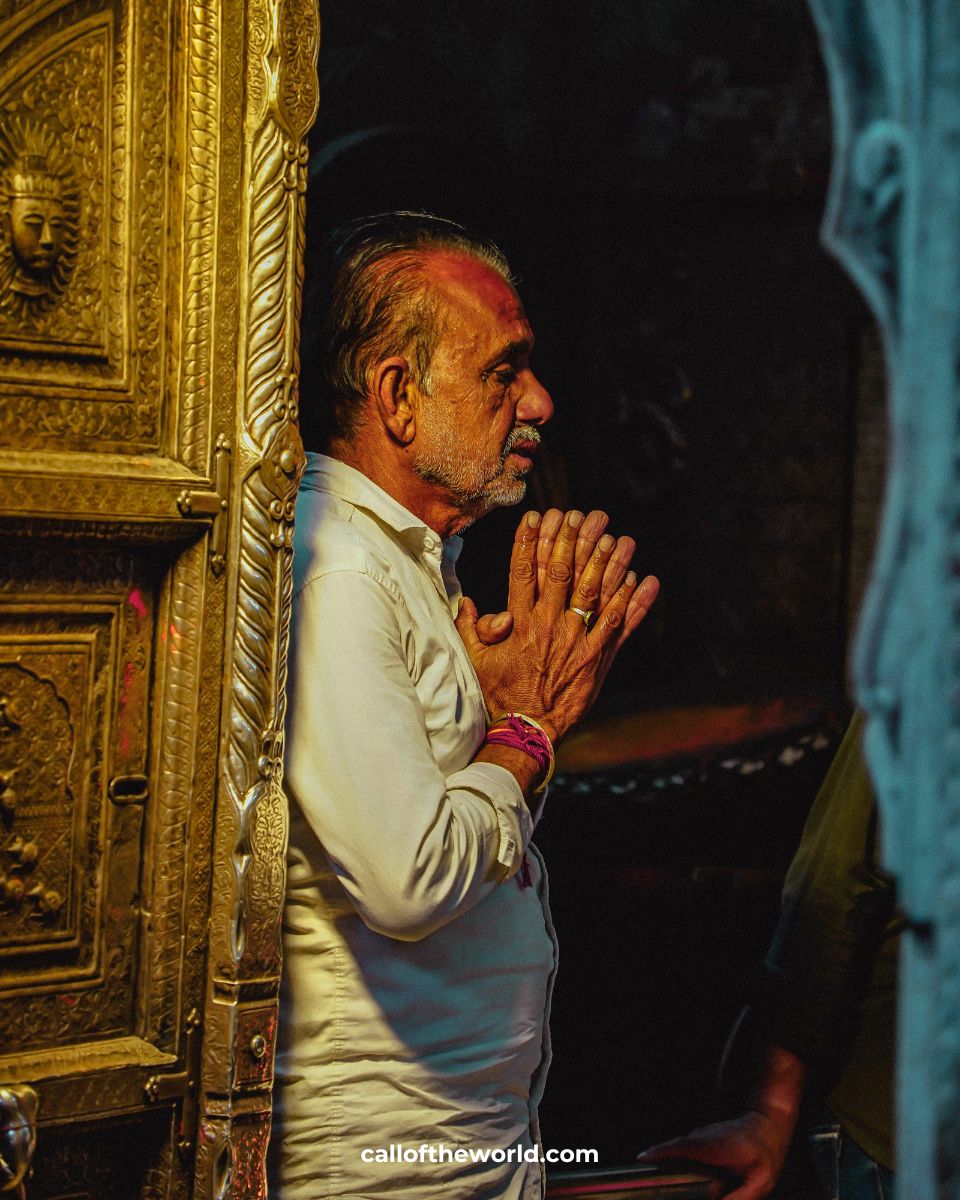
Reasons to Visit Karni Mata Temple During Your 2 Days in Bikaner:
- It’s one of the most unusual temples in India and offers a once-in-a-lifetime cultural experience.
- The temple’s architecture features intricate silver doors and marble carvings, donated by Maharaja Ganga Singh in the early 20th century.
- It’s a fascinating place to explore local legends and religious practices that are unique to Rajasthan.
- It’s a top recommendation for offbeat destinations in Bikaner and perfect for adventurous travellers or photographers.
If you’re planning your Bikaner itinerary, a morning trip to Deshnok Rat Temple is a memorable way to start the day. Pair it with nearby attractions like the Royal Cenotaphs (see below) to make the most of your 2-day stay in Bikaner.
Read my more detailed post: Visit India’s Famous Rat Temple: Karni Mata in Deshnoke, Rajasthan
Daily 4am – 10pm | free-of-charge, ₹30 camera fee
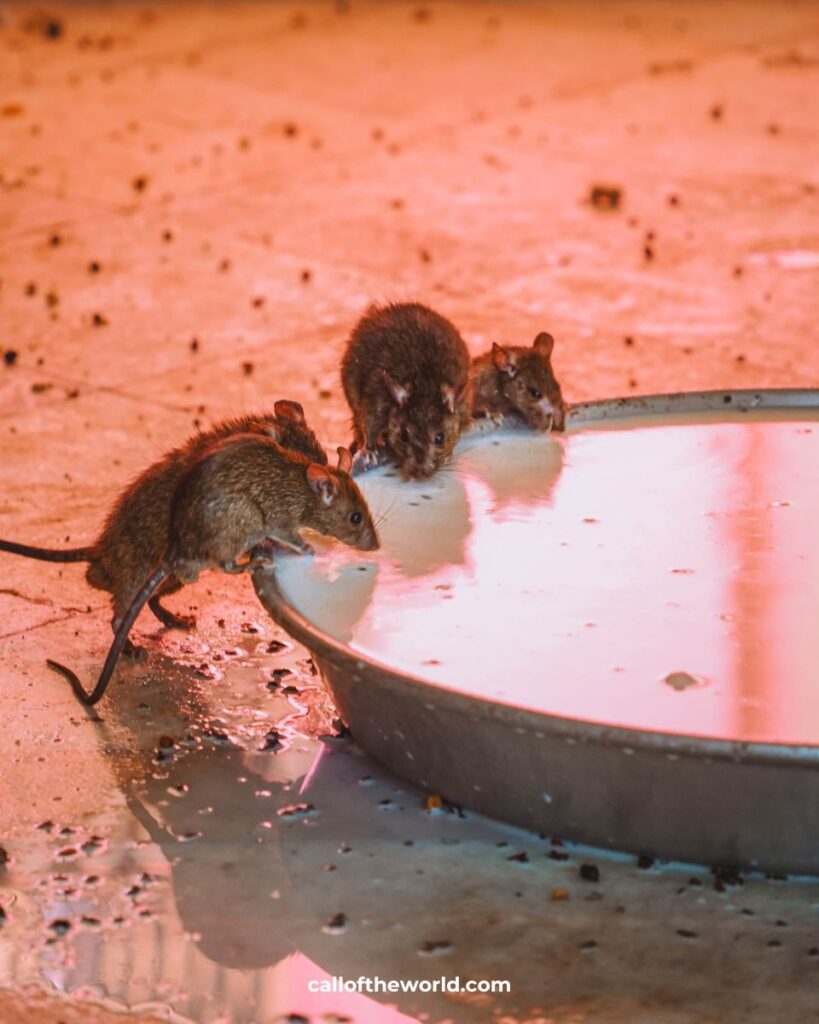
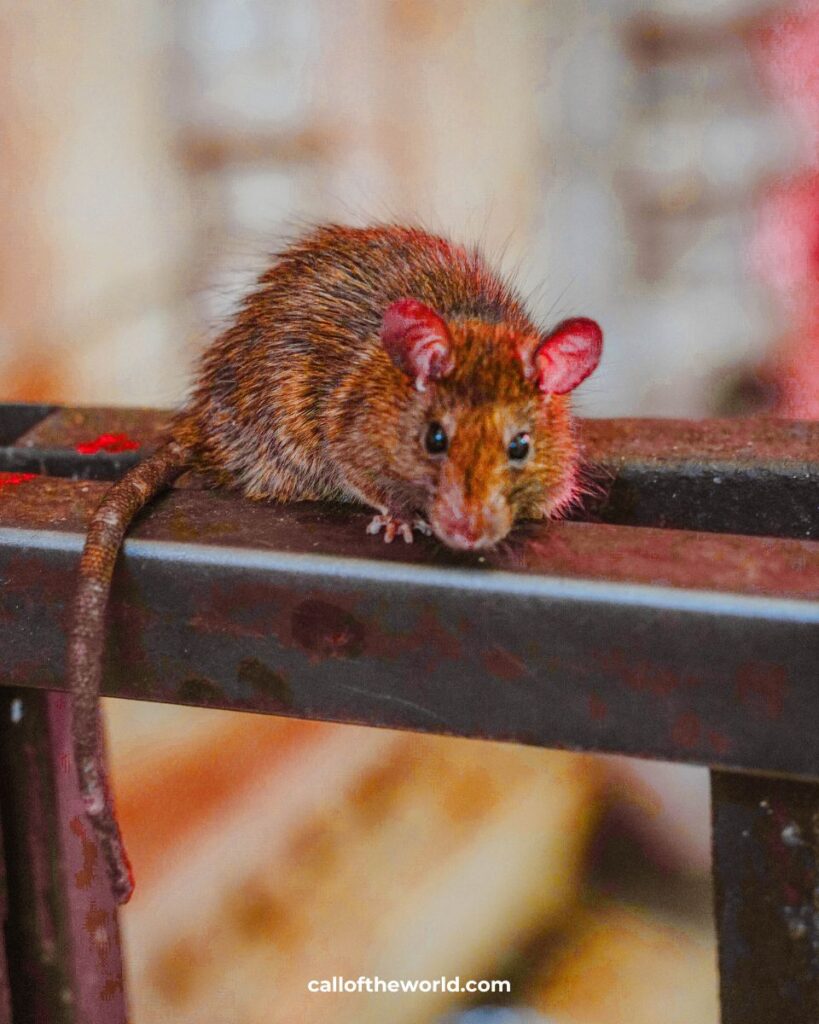
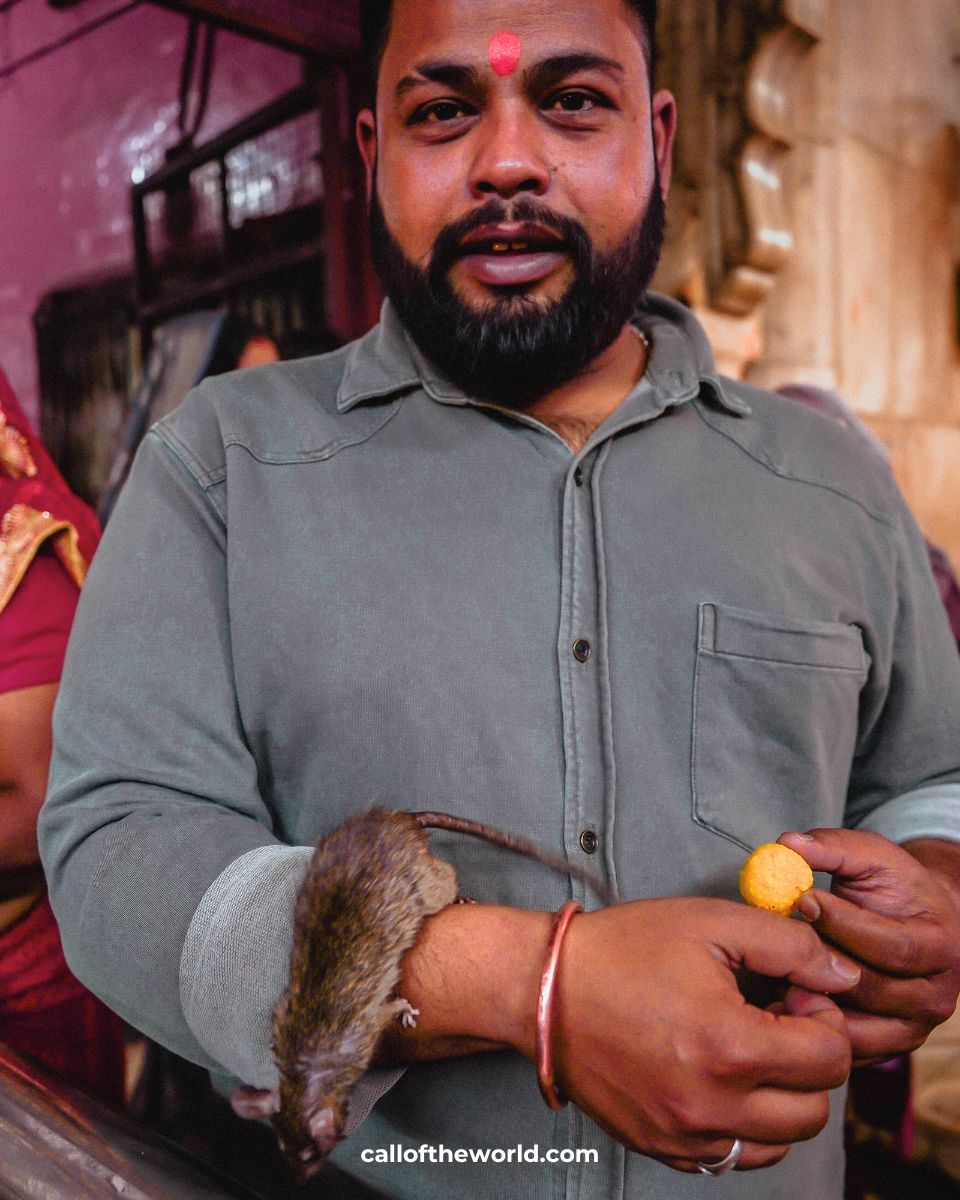
Visit the Royal Cenotaphs (Bikaner Raj Parivar Vishram Grah)
If you’re spending 2 days in Bikaner, one of the most atmospheric and lesser-known attractions to include in your itinerary is a visit to the Royal Cenotaphs, also known as the Bikaner Raj Parivar Vishram Grah.
Located just outside the main city near Devi Kund Sagar, these cenotaphs (chhatris) are elegant, dome-shaped memorials built in honour of the royal family of Bikaner. Made primarily from red and white marble, each cenotaph commemorates a different Maharaja of Bikaner, with beautifully carved pillars, detailed inscriptions and Rajput-style architectural elements that reflect the region’s noble heritage.
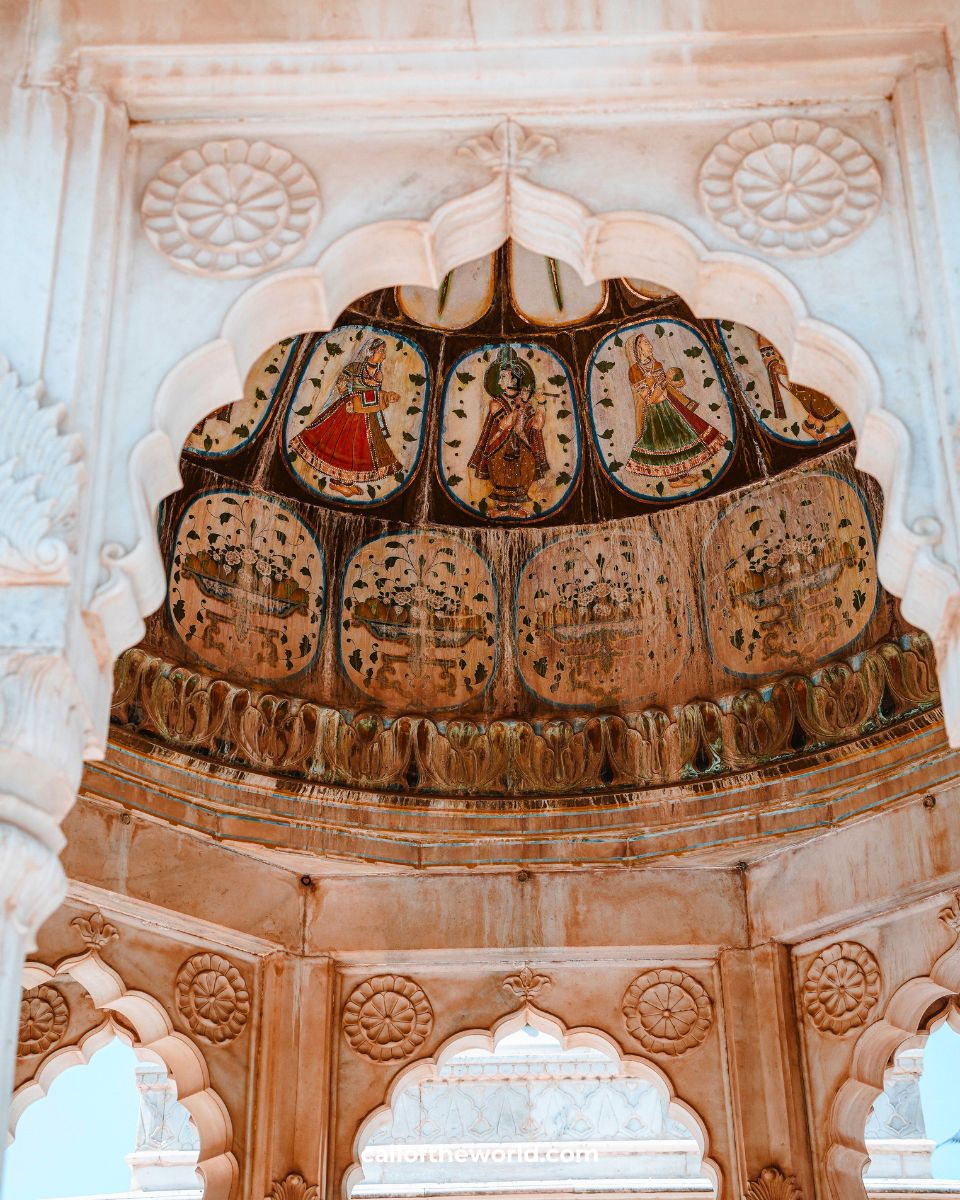
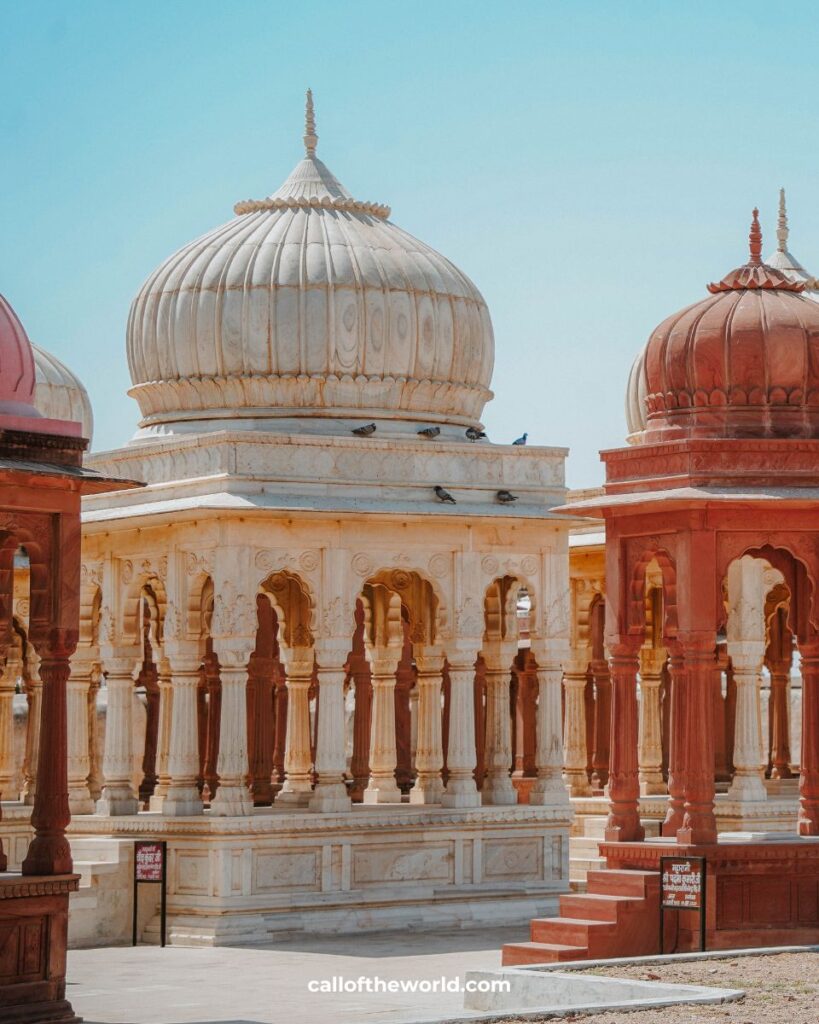

The site offers a peaceful contrast to the bustling old city. If you’re interested in Rajasthan’s royal history, Rajput architecture or hidden historical places in Bikaner, this serene complex is a must-visit. Although not as famous as the forts and palaces, the Royal Cenotaphs of Bikaner are a lovely stop for those wanting to go beyond the usual tourist trail.
A visit here helps you understand the legacy of the Bikaner royal family and adds depth to your cultural experience of the city. Don’t forget to bring water and wear respectful clothing. You need to take your shoes off when you arrive, but they provide flip flops as the ground gets quite hot!
For travellers looking to create a well-rounded 2-day Bikaner itinerary, this is an ideal offbeat gem to explore.
9am – 5pm | ₹5 for Indian nationals and ₹10 for foreign visitors
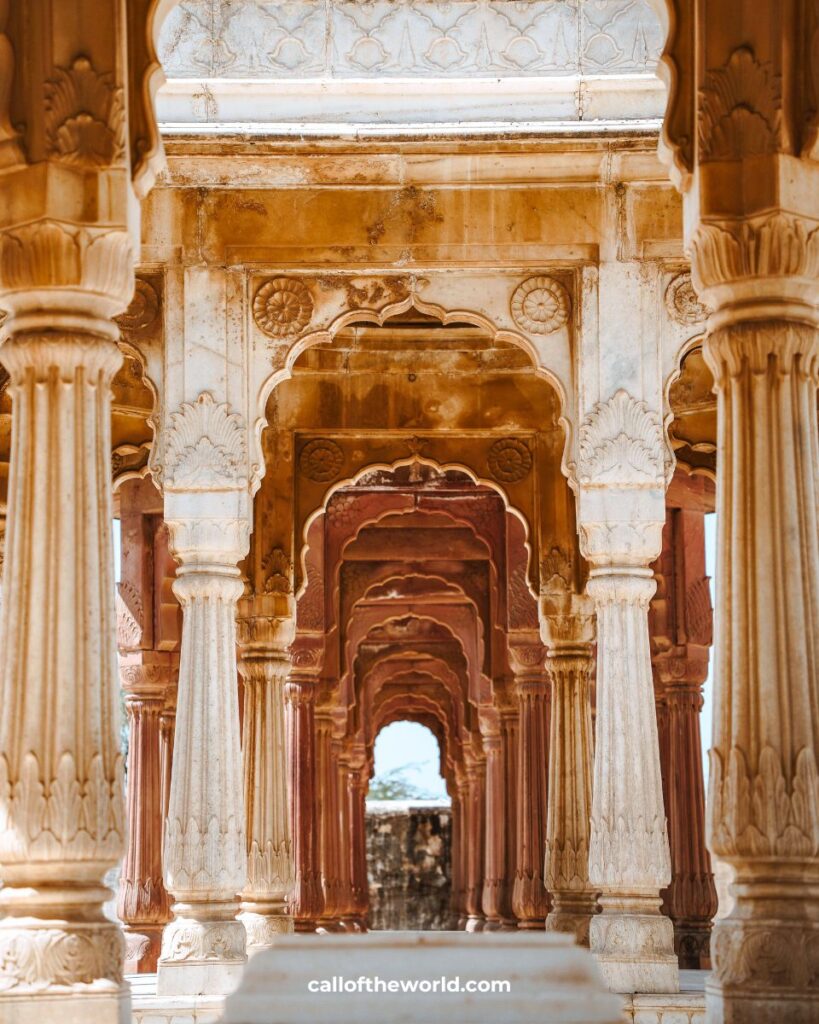
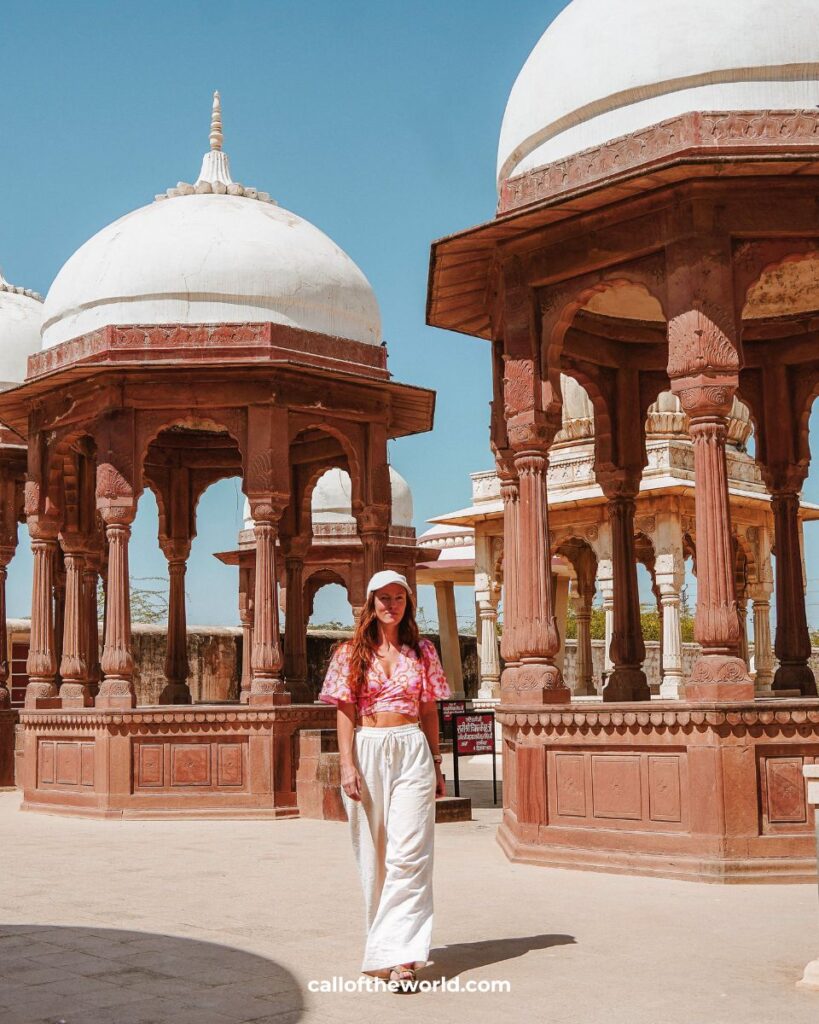

Visit the National Research Centre on Camel: A Unique Bikaner Experience
Located approximately 8km from Bikaner, the National Research Centre on Camel (NRCC) offers visitors an insightful look into the world of camels, an integral part of Rajasthan’s desert heritage. Established in 1984 under the Indian Council of Agricultural Research (ICAR), the centre focuses on camel breeding, health, and nutrition, aiming to improve the livelihoods of camel herders and promote sustainable camel farming practices.
Visitors to the NRCC can explore various facilities, including camel stables housing breeds like Bikaneri, Jaisalmeri, Kachchhi, and Mewari. The centre also features a camel museum that provides educational exhibits on the significance of camels in desert ecosystems. For those interested in unique culinary experiences, the NRCC offers camel milk products such as ice cream and kulfi. 

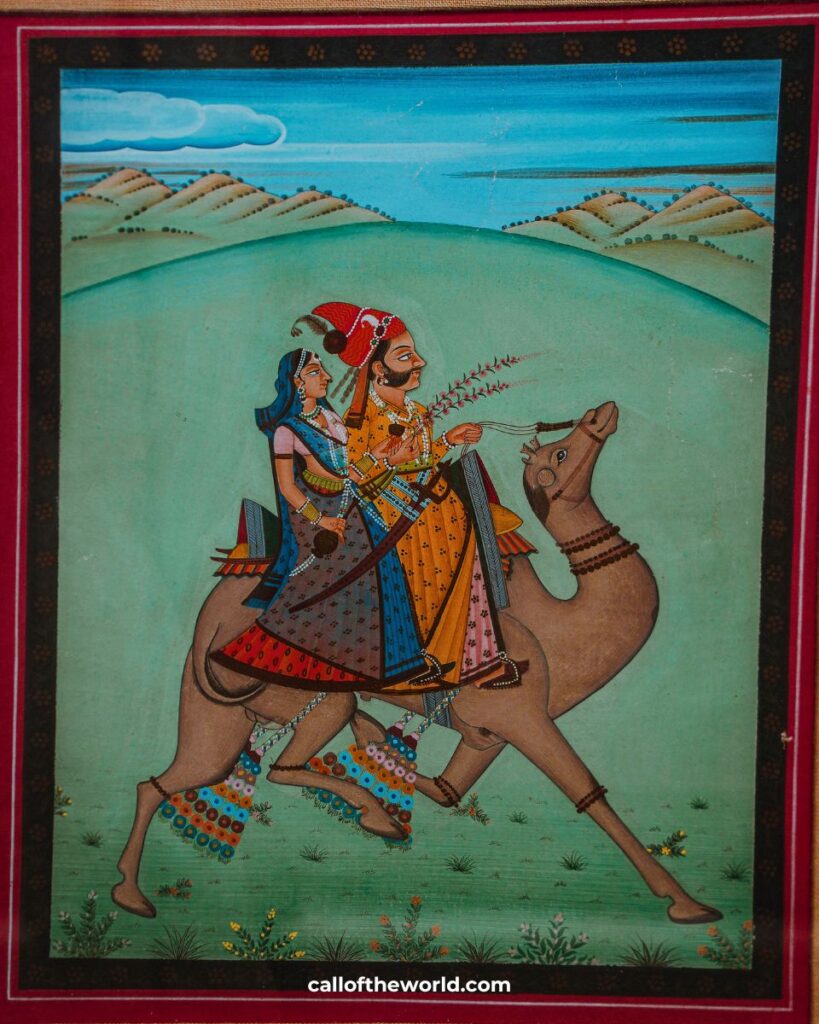
Ethical Considerations: The NRCC primarily serves as a research institution dedicated to the welfare and conservation of camels. While it offers camel rides and safaris to visitors, these activities are conducted under controlled conditions, aiming to educate the public about camels rather than exploit them. However, it’s worth noting that some animal welfare organisations have raised concerns about the use of camels in tourism in general, particularly regarding rides and performances.
Note that camels are truly domesticated animals, unlike elephants which are not and which are tamed using barbaric methods. As such, riding camels is not inherently cruel in the same way elephant riding is (elephant riding is never ok). But, care must still be taken to only ride camels in places that treat them well. Unfortunately, where money is involved this is often not the case, so, if in doubt, just avoid riding camels.
For travellers spending 2 days in Bikaner, a visit to the NRCC provides a unique opportunity to learn about camel research and the efforts being made to preserve this vital aspect of Rajasthan’s culture and economy.
2pm – 6pm (Closed on Sundays and public holidays) | ₹50 per person
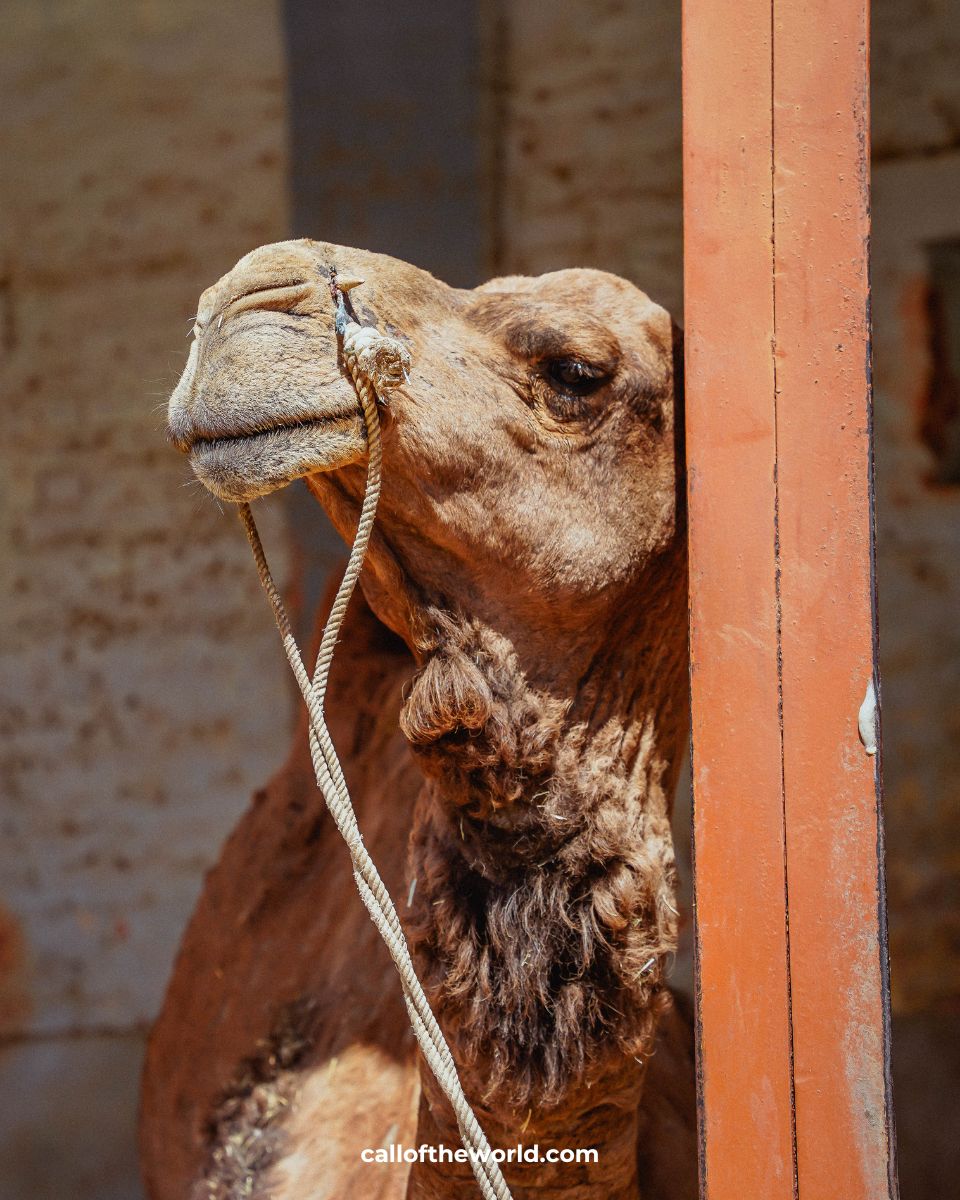
How do I get to Bikaner?
Bikaner is well connected by train, road and air, making it relatively easy to reach from other parts of Rajasthan and India.
By Train: Bikaner Junction is a major railway station with regular trains from cities like Delhi, Jaipur, Jodhpur and Udaipur. Trains are a popular choice for budget travellers and offer a scenic way to see the desert unfold.
By Bus: You can catch government and private buses to Bikaner from nearby cities. The RedBus app (connect it to your WISE card in advance – WISE enables you to pay in local currency meaning it works better with apps like this than other foreign cards) is a helpful tool for booking tickets in advance, especially for private sleeper buses or AC options. I found the sleeper buses in India excellent – just make sure to check the star review in the app and only book the well-reviewed ones.
By Air: The nearest airport is Bikaner Nal Airport (BKB), about 15 km from the city centre. However, flights are limited. For better connectivity, most travellers fly into Jaipur or Jodhpur and continue by train or road. I personally use Skyscanner to search and book all my flights – I flew domestically in India with IndiGo and everything went smoothly.
Plan Your Escape: Flight Deals to Anywhere
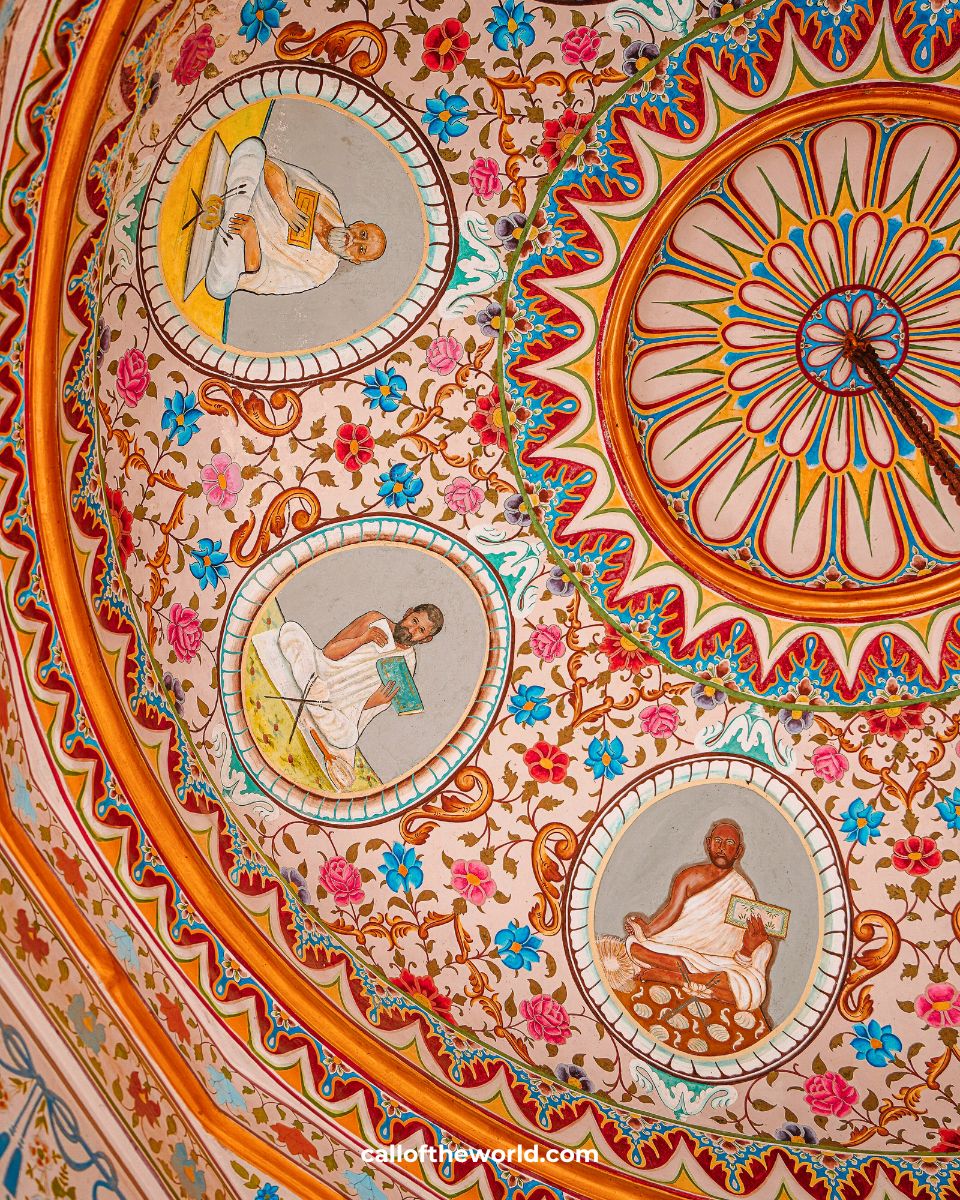
Planning Your 2 Days in Bikaner Itinerary: Map
Where to Stay for 2 Days in Bikaner

Accommodation Options in Bikaner
- Budget: Little Prince Guesthouse – A welcoming family-run guesthouse offering clean, spacious rooms with traditional Rajasthani decor. Enjoy home-cooked meals, a peaceful courtyard and warm hospitality in the heart of Bikaner’s old town. This is where I stayed and I loved it! It’s easy to meet other travellers there, and you can also book tours to rat temple etc.
- Luxury: Narendra Bhawan – A former royal residence turned boutique hotel, part of the Small Luxury Hotels of the World collection. Features eclectic interiors, a rooftop infinity pool and curated dining experiences that narrate Bikaner’s rich history.
- Luxury Heritage: The Laxmi Niwas Palace – A majestic red sandstone palace built in 1904, offering opulent rooms adorned with antique furnishings and intricate artwork. Guests can dine in the grand Swarna Mahal restaurant and experience royal hospitality reminiscent of a bygone era.
Explore more handpicked stays in Bikaner on Booking.com—from charming guesthouses to luxurious heritage hotels. Make sure to carefully check guest reviews as India is known for fake review scams.
Final Thoughts on This 2-Day Bikaner Itinerary
Bikaner might not feature on every Rajasthan itinerary, but that’s precisely what makes it so special. With its richly decorated palaces, vibrant bazaars, and quiet, camel-dotted streets, the city offers a deeper, more authentic glimpse into desert life. Over two days, you’ll have time to explore the architectural beauty of Junagarh Fort, discover local crafts in the old city, and enjoy delicious Rajasthani food without the usual tourist crowds.
Whether you’re weaving Bikaner into a longer Rajasthan route or using it as a peaceful detour, this two-day itinerary strikes the perfect balance between culture, history, and local charm. It’s a place that invites you to slow down, look closer, and connect more deeply with the stories of the region.
🌟 A friendly reminder to get travel insurance for your trip! The desert climate can be tough and you just never know what might happen – always best to be prepared. Call of the World readers get a 5% discount on Heymondo travel insurance using this link.
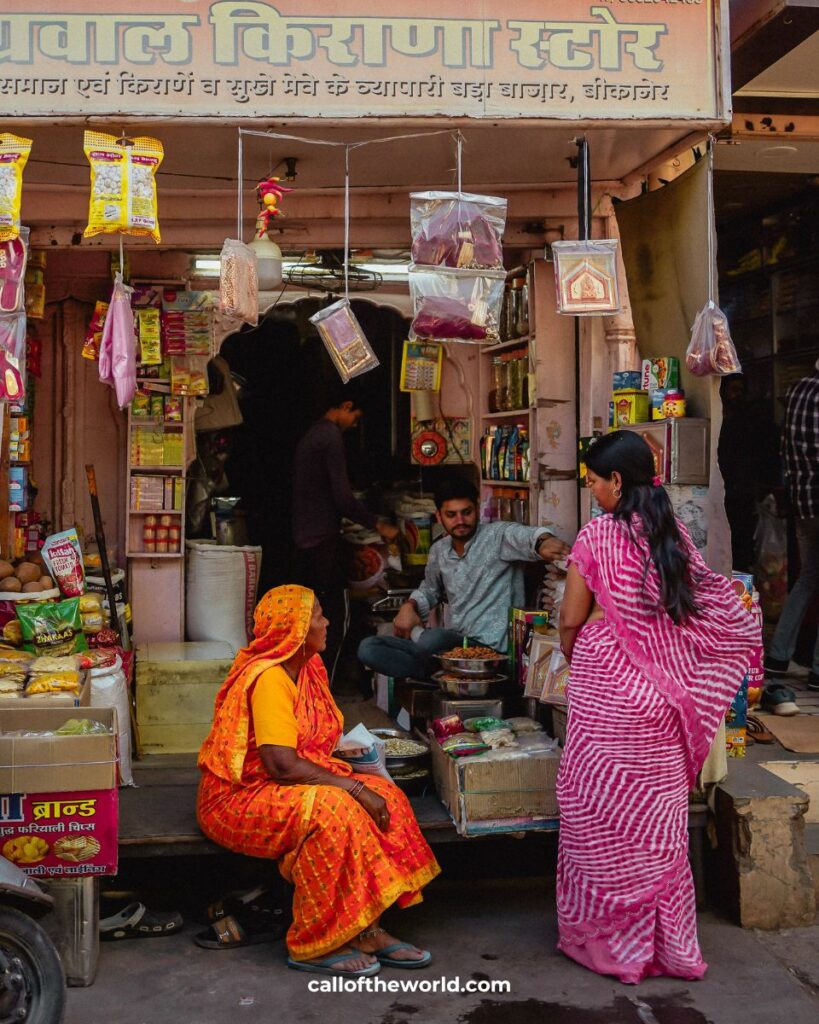
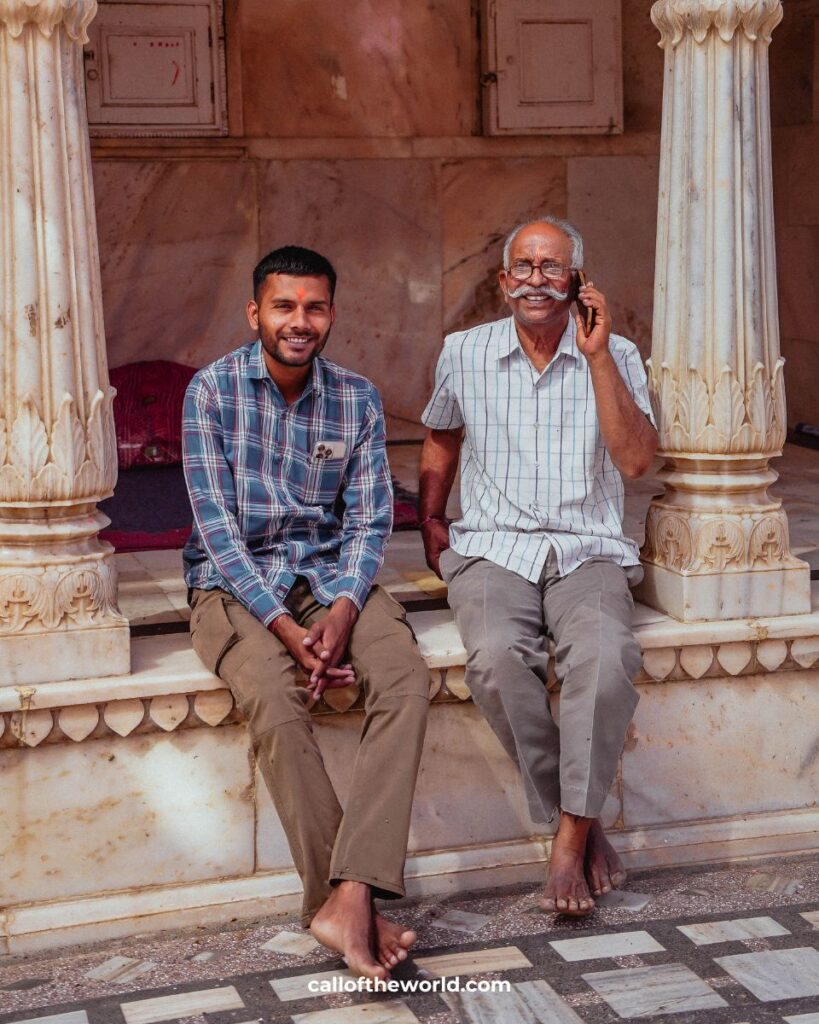
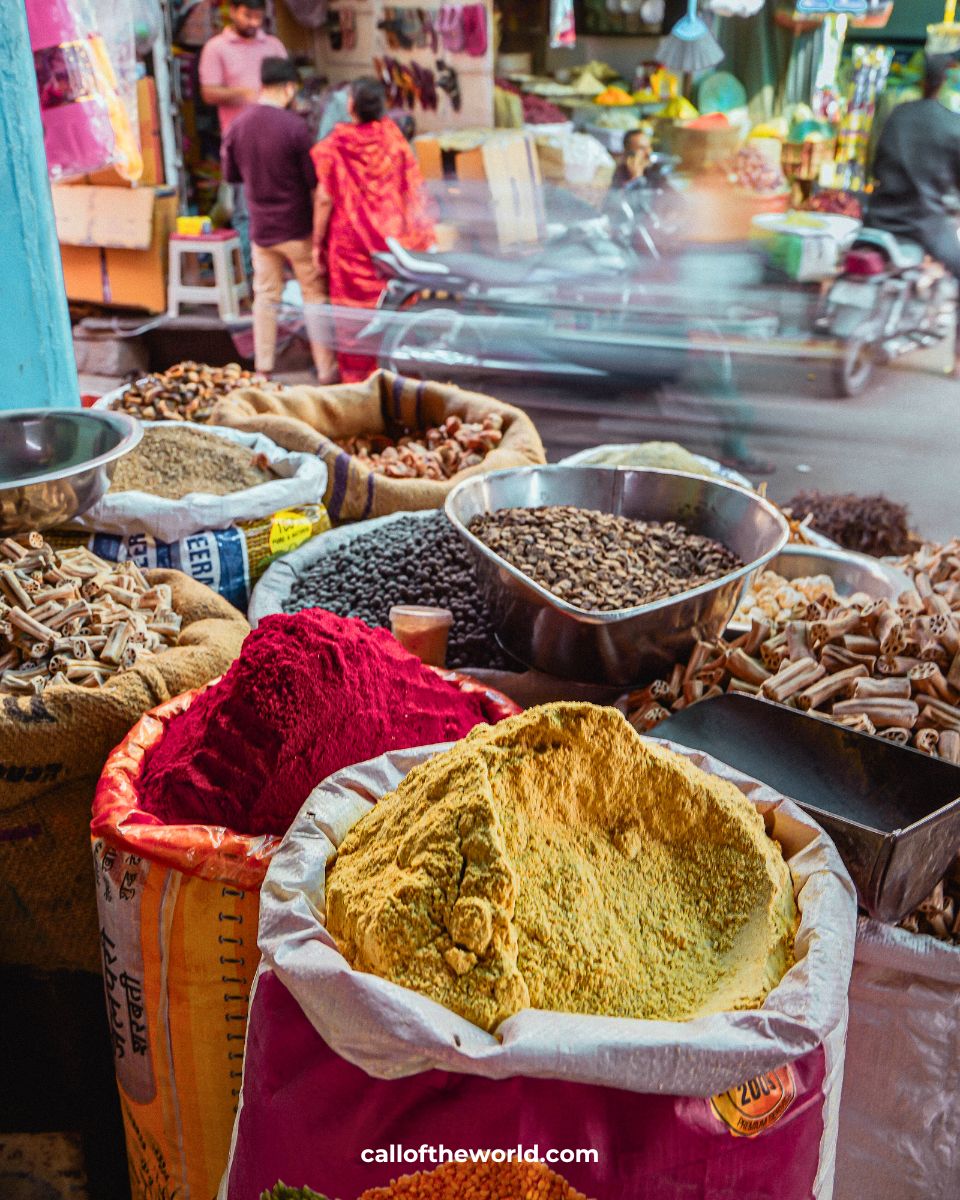
FAQs About Visiting Bikaner, India
Top attractions in Bikaner include Junagarh Fort, the Rampuria Havelis, Karni Mata Temple (also known as the Rat Temple), the National Research Centre on Camel, and the bustling Old City bazaars. These sites offer a mix of history, architecture, and local culture.
Bikaner is renowned for its culinary delights. Must-try dishes include Bikaneri Bhujia, Raj Kachori, Shahi Samosa, Papad ki Sabzi, Gatte ki Sabzi, and sweets like Bikaneri Rasgulla and Kesar Kulfi. Don’t miss the traditional sharbat served in earthen cups.
Spending 2 days in Bikaner is sufficient to cover the main attractions, enjoy local cuisine, and experience the city’s rich heritage. This timeframe allows for a comfortable pace without feeling rushed.
The ideal time to visit Bikaner is between October and March when the weather is cooler and more pleasant. This period also coincides with several local festivals, offering a vibrant cultural experience.
Packing for Bikaner requires a bit of preparation due to the desert climate. Essentials include high-SPF sun cream, a wide-brimmed hat or scarf for sun protection, and lightweight, breathable clothing. The dry air can be harsh on skin, so bring a good lip balm, hand cream, and facial moisturiser. Sunglasses and a reusable water bottle are must-haves, and it’s wise to carry hand sanitiser and tissues for comfort while exploring local markets and temples. If you’re visiting in winter, include a warm layer for the chilly mornings and evenings.
Bikaner is generally considered safe for solo female travellers, especially compared to more crowded tourist hotspots. Locals are warm and welcoming, and the city sees fewer touts and scams than places like Delhi or Jaipur. However, it’s still wise to dress modestly, avoid walking alone at night, and trust your instincts. Stick to well-reviewed accommodation and consider booking guided tours or transport in advance or directly with your accommodation provider for peace of mind. A lightweight scarf can be useful both for sun protection and for covering your head when visiting temples.
Yes, Bikaner is family-friendly with attractions like Junagarh Fort, the Camel Research Centre, and various temples. The city’s rich history and culture provide educational experiences for children and adults alike.
Unique experiences in Bikaner include visiting the Karni Mata Temple, known for its sacred rats, exploring the intricately designed Rampuria Havelis, and sampling camel milk products at the National Research Centre on Camel.
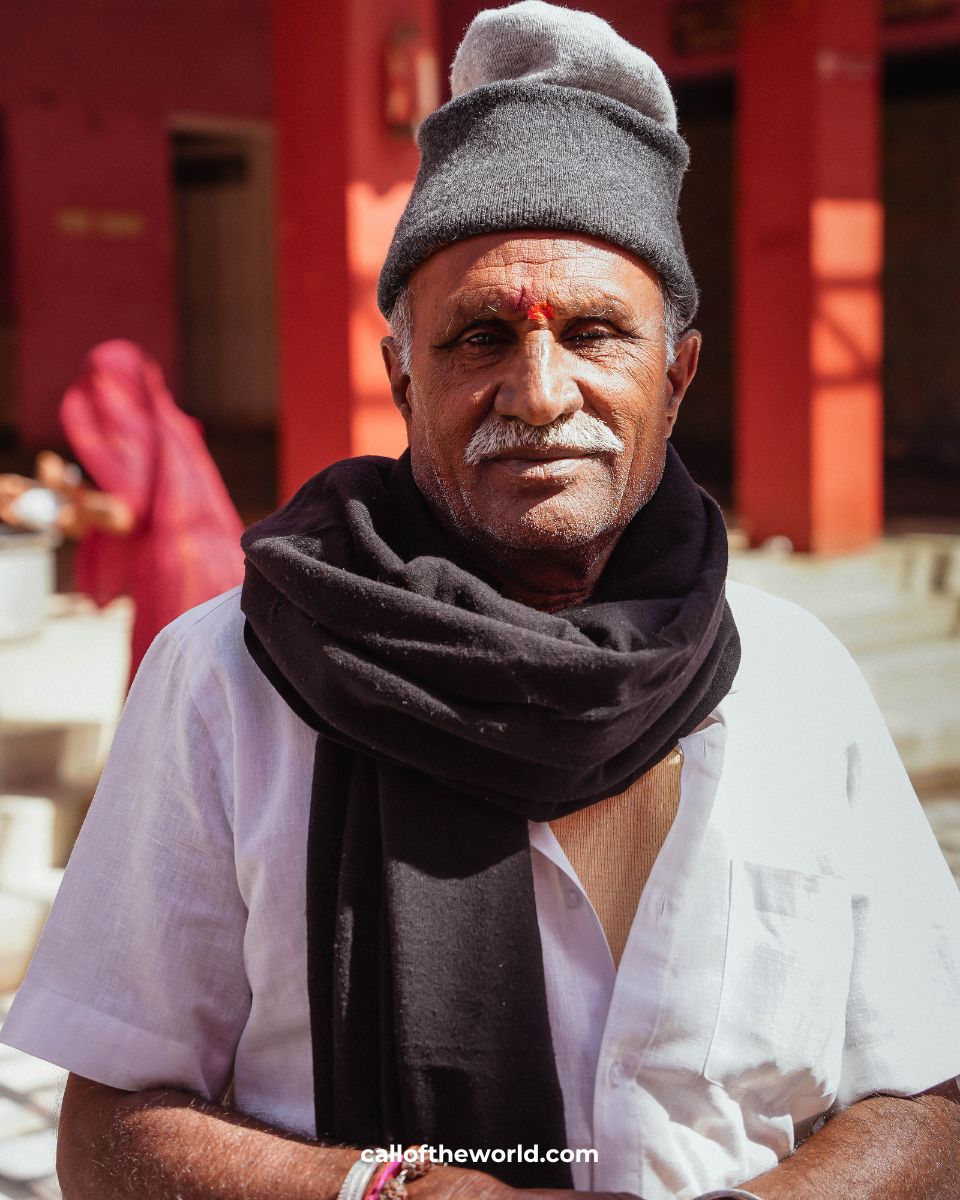
Plan Your Trip to India: Useful Travel Resources
Planning your next trip? These are my ride-or-die travel tools — handpicked, tested, and essential. The smart stuff I actually use to book fast, travel safer, and stress less. I don’t gatekeep when it comes to travel!
Travel Insurance
- SafetyWingNomad-friendly, low-cost, and claim-friendly. Built for long-term travellers.
- Heymondo (5% off)Great app. Fast claims. Reader discount included.
Flights
- SkyscannerThe only tool I trust to find the cheapest flights in seconds.
Money & Banking
- WiseNo hidden fees, epic exchange rates — perfect for multi-country trips.
Accommodation
- Booking.comFree cancellation, last-minute deals — ideal for the flexible traveller.
Transport
- 12GoBuses, trains, ferries across Asia — easy, fast, and reliable.
- Welcome PickupsPrivate airport pickups with friendly local drivers. Book in advance and relax.
Tours & Tickets
- ViatorSkip the queue, book activities last-minute, cancel for free.
- G AdventuresSmall-group tours, ethical operators, great for solo travel.
eSIMs & Data
- AiraloDigital SIM cards you can activate instantly. No roaming bills, ever.
- Holafly (5% off with code “CALLOFTHEWORLD”)Unlimited data. 100+ countries. Set it up in 5 minutes.
- Saily (5% off with code “SPECIAL5”)Affordable eSIMs that just work, especially in Southeast Asia.
Stay Secure
- NordVPNBrowse safely on public Wi-Fi, access content globally, and stay private.
- ExpressVPNFast, reliable, and works in countries with heavy censorship.
✈️ Pro tip: Set these up before your trip so you can hit the ground running. Travel smarter, not harder.
Pin it for later…
Was this India travel guide about 2 Days in Bikaner: What to See in Rajasthan’s Red City useful for you? Save it on Pinterest and follow along on Instagram for some escapism and more adventure tips.
Have you been to India? What was your favourite spot? Let me know in the comments!
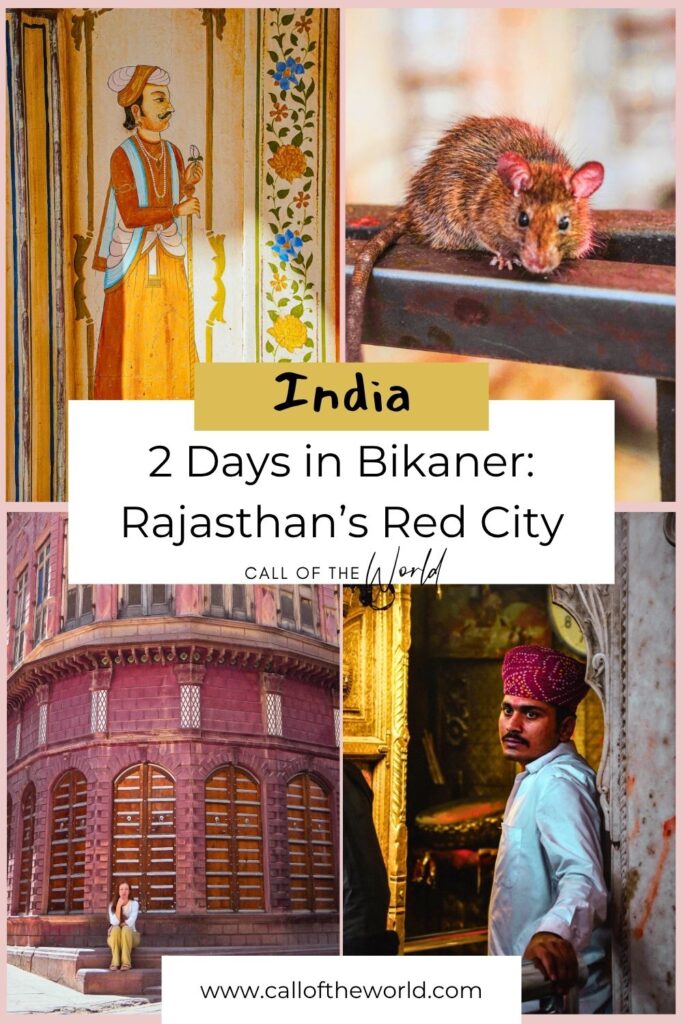
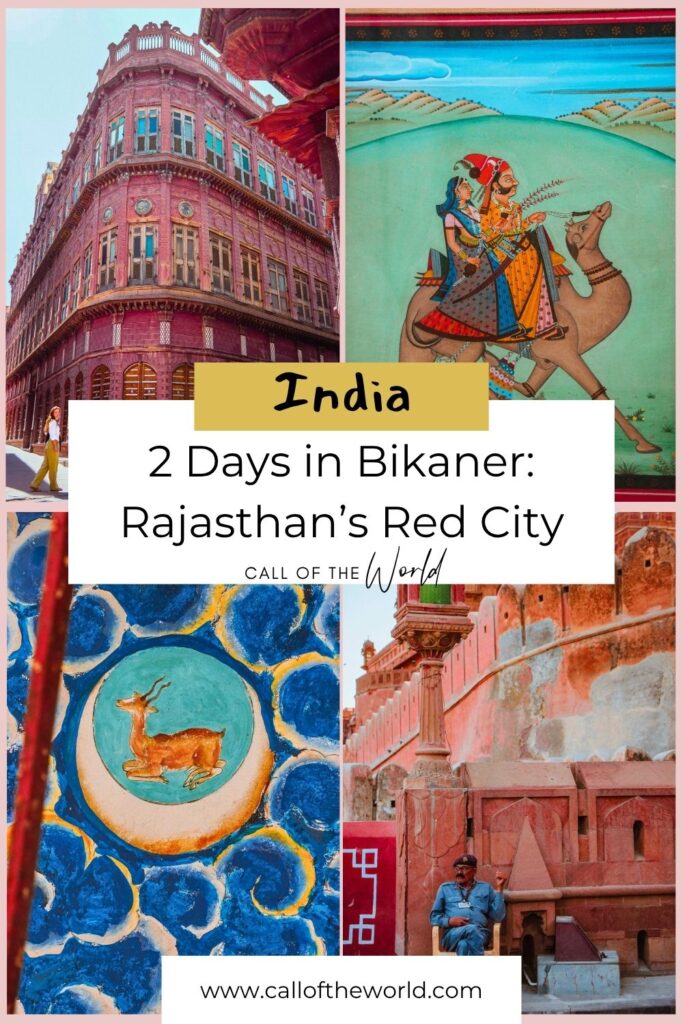



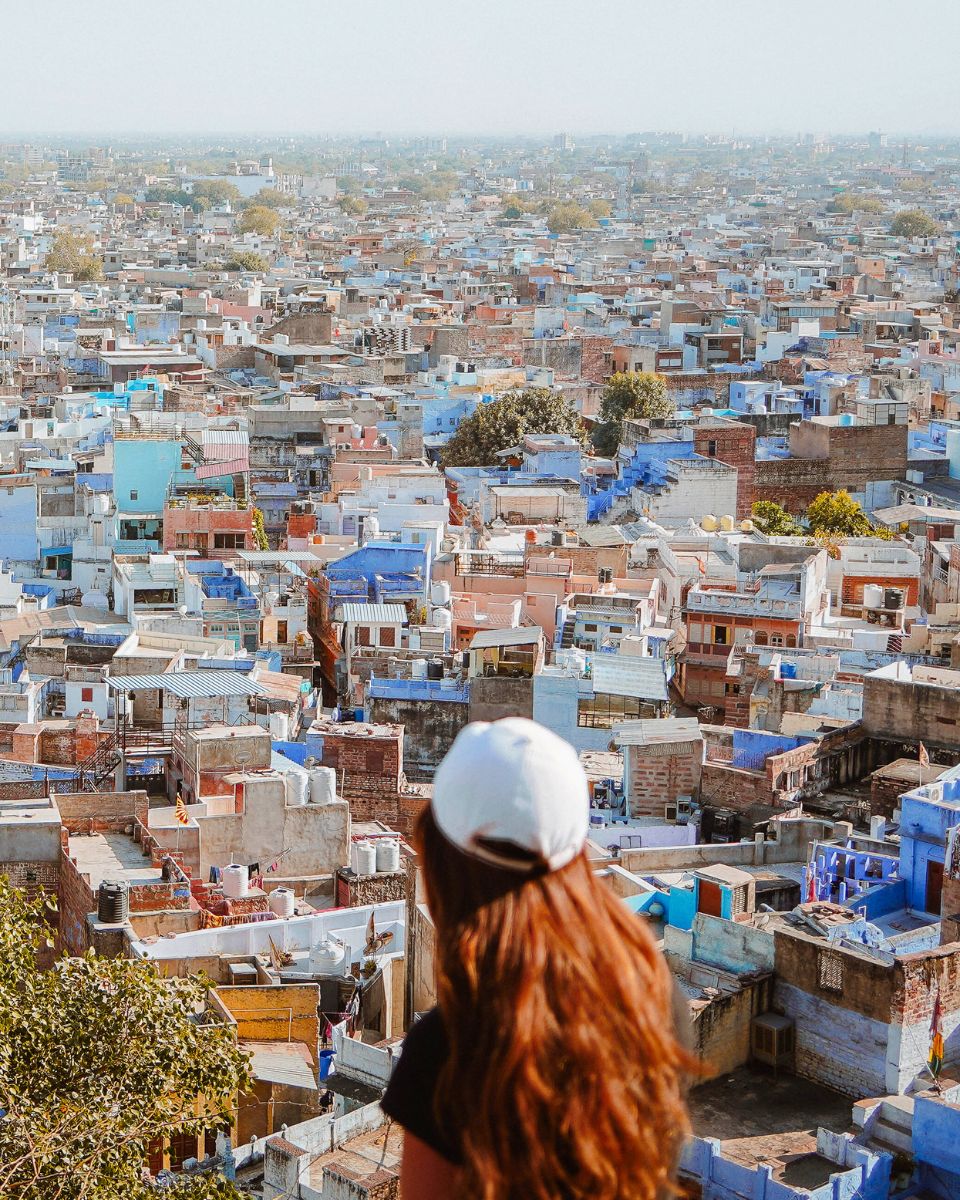


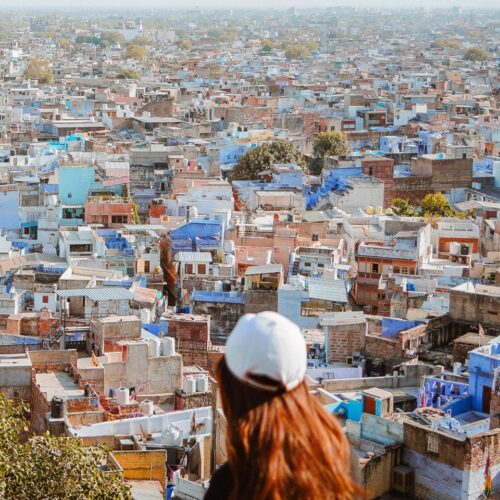


Leave a Reply